WHS Management System Review for University of Sydney
VerifiedAdded on 2023/06/11
|37
|7727
|136
AI Summary
This article provides an overview of the WHS management system review for the University of Sydney, including its hazard identification and risk management system, legal and regulatory obligations, and workplace inspection checklist.
Contribute Materials
Your contribution can guide someone’s learning journey. Share your
documents today.
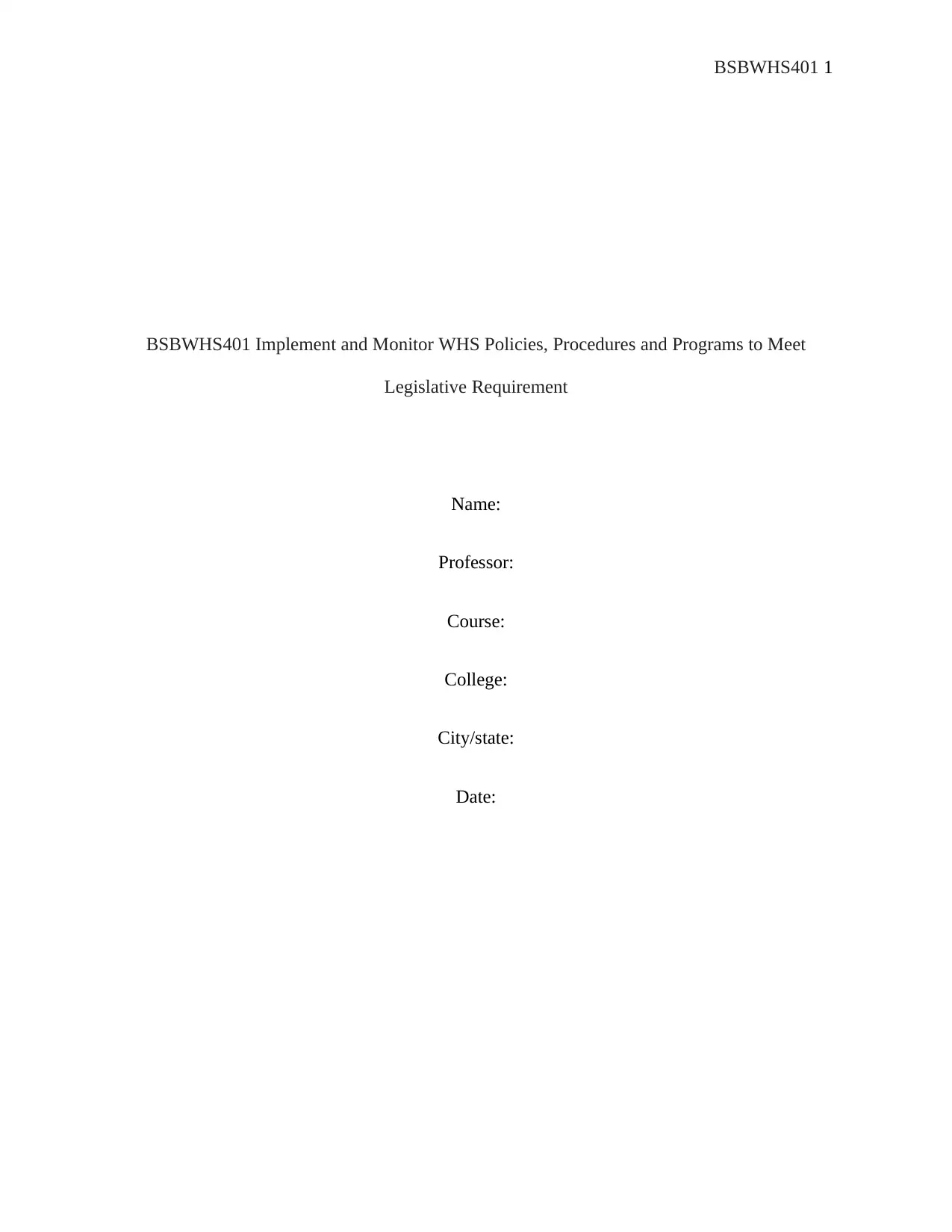
BSBWHS401 1
BSBWHS401 Implement and Monitor WHS Policies, Procedures and Programs to Meet
Legislative Requirement
Name:
Professor:
Course:
College:
City/state:
Date:
BSBWHS401 Implement and Monitor WHS Policies, Procedures and Programs to Meet
Legislative Requirement
Name:
Professor:
Course:
College:
City/state:
Date:
Secure Best Marks with AI Grader
Need help grading? Try our AI Grader for instant feedback on your assignments.

BSBWHS401 2
Part 1 A: WHS Management System Review
Task: 1
WHS Management System Review
The University of Sydney has all the procedures which ensure that the students, affiliates
and staff of the university are never exposed to the health and safety hazards and risks in the
workplace or the premises on the university. Such regulations and procedures have been
formulated in a way that they comply with the work health and safety policy 2016. It is worth
mentioning that the basic purpose of work health and safety legislation is to ensure that
employers systematically manage risks which arise from hazards in the workplace. The
employers have the responsibility to effectively consult and communicate the risks and health
hazards to the employees. It can be stated that the risk management system of the University of
Sydney has been developed in a way which assists the university for the purpose of achieving
compliance with the health and safety regulations and legislation. This system imposes the
responsibility on the managers and the staff members of the university to oversee the activities of
the students and other staff. It is worth mentioning that the process Work health and Safety risk
management in the University of Sydney involves five steps. They are:
Identification of the hazards and the jobs that are hazardous
Assessing the priority for the each of the hazardous jobs and the hazards
Assessing the risks associated with the hazardous acts and jobs
Controlling the risks for the purpose of fixing the problems
Part 1 A: WHS Management System Review
Task: 1
WHS Management System Review
The University of Sydney has all the procedures which ensure that the students, affiliates
and staff of the university are never exposed to the health and safety hazards and risks in the
workplace or the premises on the university. Such regulations and procedures have been
formulated in a way that they comply with the work health and safety policy 2016. It is worth
mentioning that the basic purpose of work health and safety legislation is to ensure that
employers systematically manage risks which arise from hazards in the workplace. The
employers have the responsibility to effectively consult and communicate the risks and health
hazards to the employees. It can be stated that the risk management system of the University of
Sydney has been developed in a way which assists the university for the purpose of achieving
compliance with the health and safety regulations and legislation. This system imposes the
responsibility on the managers and the staff members of the university to oversee the activities of
the students and other staff. It is worth mentioning that the process Work health and Safety risk
management in the University of Sydney involves five steps. They are:
Identification of the hazards and the jobs that are hazardous
Assessing the priority for the each of the hazardous jobs and the hazards
Assessing the risks associated with the hazardous acts and jobs
Controlling the risks for the purpose of fixing the problems
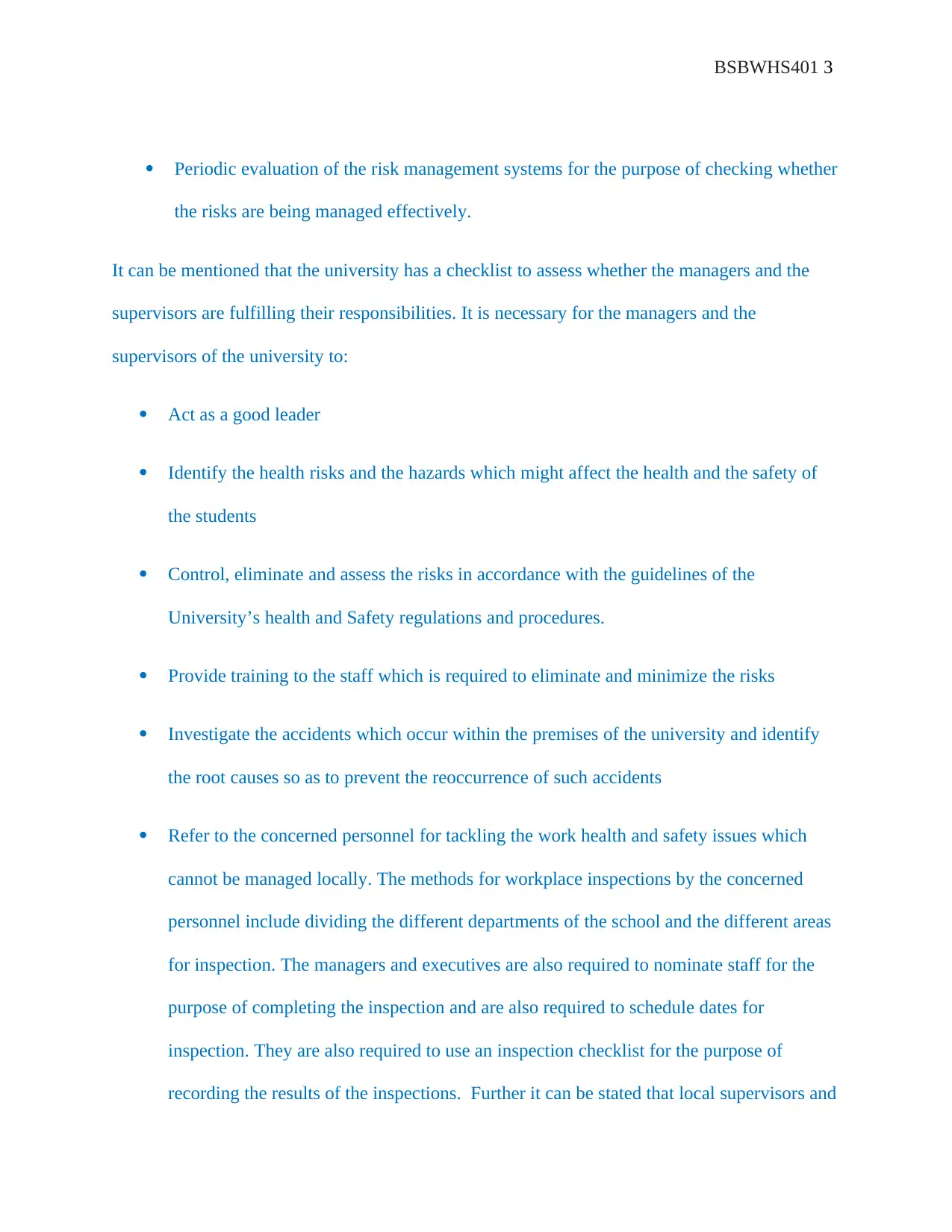
BSBWHS401 3
Periodic evaluation of the risk management systems for the purpose of checking whether
the risks are being managed effectively.
It can be mentioned that the university has a checklist to assess whether the managers and the
supervisors are fulfilling their responsibilities. It is necessary for the managers and the
supervisors of the university to:
Act as a good leader
Identify the health risks and the hazards which might affect the health and the safety of
the students
Control, eliminate and assess the risks in accordance with the guidelines of the
University’s health and Safety regulations and procedures.
Provide training to the staff which is required to eliminate and minimize the risks
Investigate the accidents which occur within the premises of the university and identify
the root causes so as to prevent the reoccurrence of such accidents
Refer to the concerned personnel for tackling the work health and safety issues which
cannot be managed locally. The methods for workplace inspections by the concerned
personnel include dividing the different departments of the school and the different areas
for inspection. The managers and executives are also required to nominate staff for the
purpose of completing the inspection and are also required to schedule dates for
inspection. They are also required to use an inspection checklist for the purpose of
recording the results of the inspections. Further it can be stated that local supervisors and
Periodic evaluation of the risk management systems for the purpose of checking whether
the risks are being managed effectively.
It can be mentioned that the university has a checklist to assess whether the managers and the
supervisors are fulfilling their responsibilities. It is necessary for the managers and the
supervisors of the university to:
Act as a good leader
Identify the health risks and the hazards which might affect the health and the safety of
the students
Control, eliminate and assess the risks in accordance with the guidelines of the
University’s health and Safety regulations and procedures.
Provide training to the staff which is required to eliminate and minimize the risks
Investigate the accidents which occur within the premises of the university and identify
the root causes so as to prevent the reoccurrence of such accidents
Refer to the concerned personnel for tackling the work health and safety issues which
cannot be managed locally. The methods for workplace inspections by the concerned
personnel include dividing the different departments of the school and the different areas
for inspection. The managers and executives are also required to nominate staff for the
purpose of completing the inspection and are also required to schedule dates for
inspection. They are also required to use an inspection checklist for the purpose of
recording the results of the inspections. Further it can be stated that local supervisors and
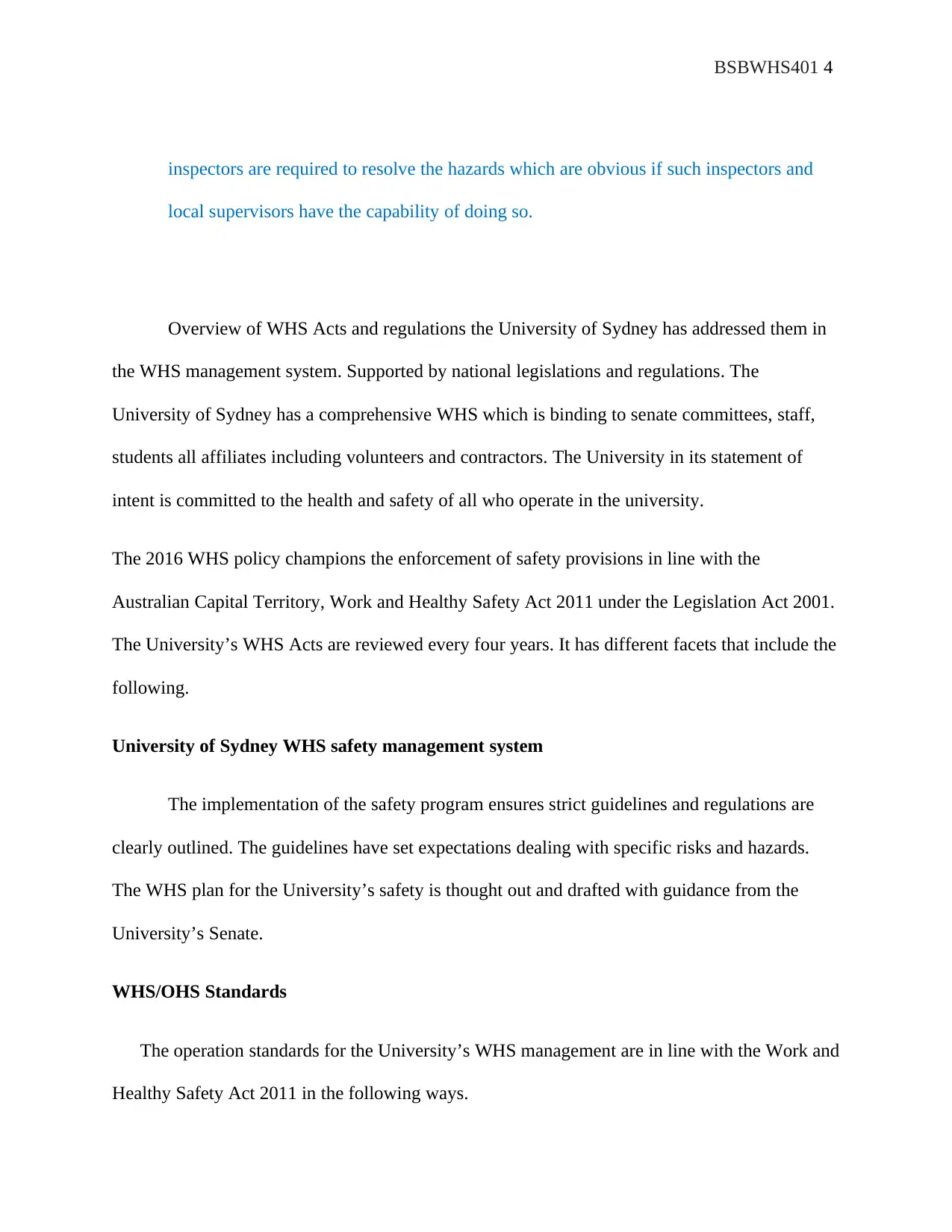
BSBWHS401 4
inspectors are required to resolve the hazards which are obvious if such inspectors and
local supervisors have the capability of doing so.
Overview of WHS Acts and regulations the University of Sydney has addressed them in
the WHS management system. Supported by national legislations and regulations. The
University of Sydney has a comprehensive WHS which is binding to senate committees, staff,
students all affiliates including volunteers and contractors. The University in its statement of
intent is committed to the health and safety of all who operate in the university.
The 2016 WHS policy champions the enforcement of safety provisions in line with the
Australian Capital Territory, Work and Healthy Safety Act 2011 under the Legislation Act 2001.
The University’s WHS Acts are reviewed every four years. It has different facets that include the
following.
University of Sydney WHS safety management system
The implementation of the safety program ensures strict guidelines and regulations are
clearly outlined. The guidelines have set expectations dealing with specific risks and hazards.
The WHS plan for the University’s safety is thought out and drafted with guidance from the
University’s Senate.
WHS/OHS Standards
The operation standards for the University’s WHS management are in line with the Work and
Healthy Safety Act 2011 in the following ways.
inspectors are required to resolve the hazards which are obvious if such inspectors and
local supervisors have the capability of doing so.
Overview of WHS Acts and regulations the University of Sydney has addressed them in
the WHS management system. Supported by national legislations and regulations. The
University of Sydney has a comprehensive WHS which is binding to senate committees, staff,
students all affiliates including volunteers and contractors. The University in its statement of
intent is committed to the health and safety of all who operate in the university.
The 2016 WHS policy champions the enforcement of safety provisions in line with the
Australian Capital Territory, Work and Healthy Safety Act 2011 under the Legislation Act 2001.
The University’s WHS Acts are reviewed every four years. It has different facets that include the
following.
University of Sydney WHS safety management system
The implementation of the safety program ensures strict guidelines and regulations are
clearly outlined. The guidelines have set expectations dealing with specific risks and hazards.
The WHS plan for the University’s safety is thought out and drafted with guidance from the
University’s Senate.
WHS/OHS Standards
The operation standards for the University’s WHS management are in line with the Work and
Healthy Safety Act 2011 in the following ways.
Secure Best Marks with AI Grader
Need help grading? Try our AI Grader for instant feedback on your assignments.
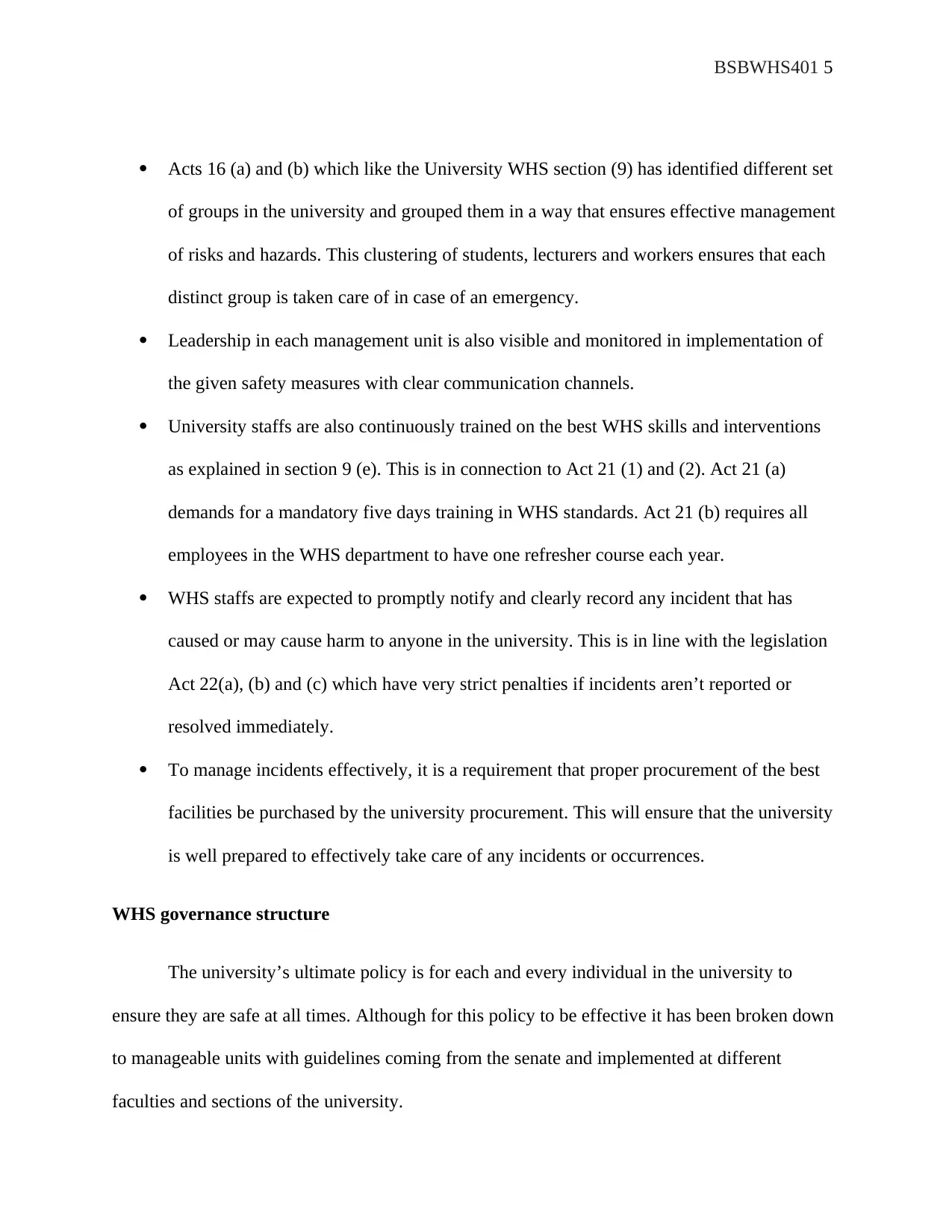
BSBWHS401 5
Acts 16 (a) and (b) which like the University WHS section (9) has identified different set
of groups in the university and grouped them in a way that ensures effective management
of risks and hazards. This clustering of students, lecturers and workers ensures that each
distinct group is taken care of in case of an emergency.
Leadership in each management unit is also visible and monitored in implementation of
the given safety measures with clear communication channels.
University staffs are also continuously trained on the best WHS skills and interventions
as explained in section 9 (e). This is in connection to Act 21 (1) and (2). Act 21 (a)
demands for a mandatory five days training in WHS standards. Act 21 (b) requires all
employees in the WHS department to have one refresher course each year.
WHS staffs are expected to promptly notify and clearly record any incident that has
caused or may cause harm to anyone in the university. This is in line with the legislation
Act 22(a), (b) and (c) which have very strict penalties if incidents aren’t reported or
resolved immediately.
To manage incidents effectively, it is a requirement that proper procurement of the best
facilities be purchased by the university procurement. This will ensure that the university
is well prepared to effectively take care of any incidents or occurrences.
WHS governance structure
The university’s ultimate policy is for each and every individual in the university to
ensure they are safe at all times. Although for this policy to be effective it has been broken down
to manageable units with guidelines coming from the senate and implemented at different
faculties and sections of the university.
Acts 16 (a) and (b) which like the University WHS section (9) has identified different set
of groups in the university and grouped them in a way that ensures effective management
of risks and hazards. This clustering of students, lecturers and workers ensures that each
distinct group is taken care of in case of an emergency.
Leadership in each management unit is also visible and monitored in implementation of
the given safety measures with clear communication channels.
University staffs are also continuously trained on the best WHS skills and interventions
as explained in section 9 (e). This is in connection to Act 21 (1) and (2). Act 21 (a)
demands for a mandatory five days training in WHS standards. Act 21 (b) requires all
employees in the WHS department to have one refresher course each year.
WHS staffs are expected to promptly notify and clearly record any incident that has
caused or may cause harm to anyone in the university. This is in line with the legislation
Act 22(a), (b) and (c) which have very strict penalties if incidents aren’t reported or
resolved immediately.
To manage incidents effectively, it is a requirement that proper procurement of the best
facilities be purchased by the university procurement. This will ensure that the university
is well prepared to effectively take care of any incidents or occurrences.
WHS governance structure
The university’s ultimate policy is for each and every individual in the university to
ensure they are safe at all times. Although for this policy to be effective it has been broken down
to manageable units with guidelines coming from the senate and implemented at different
faculties and sections of the university.
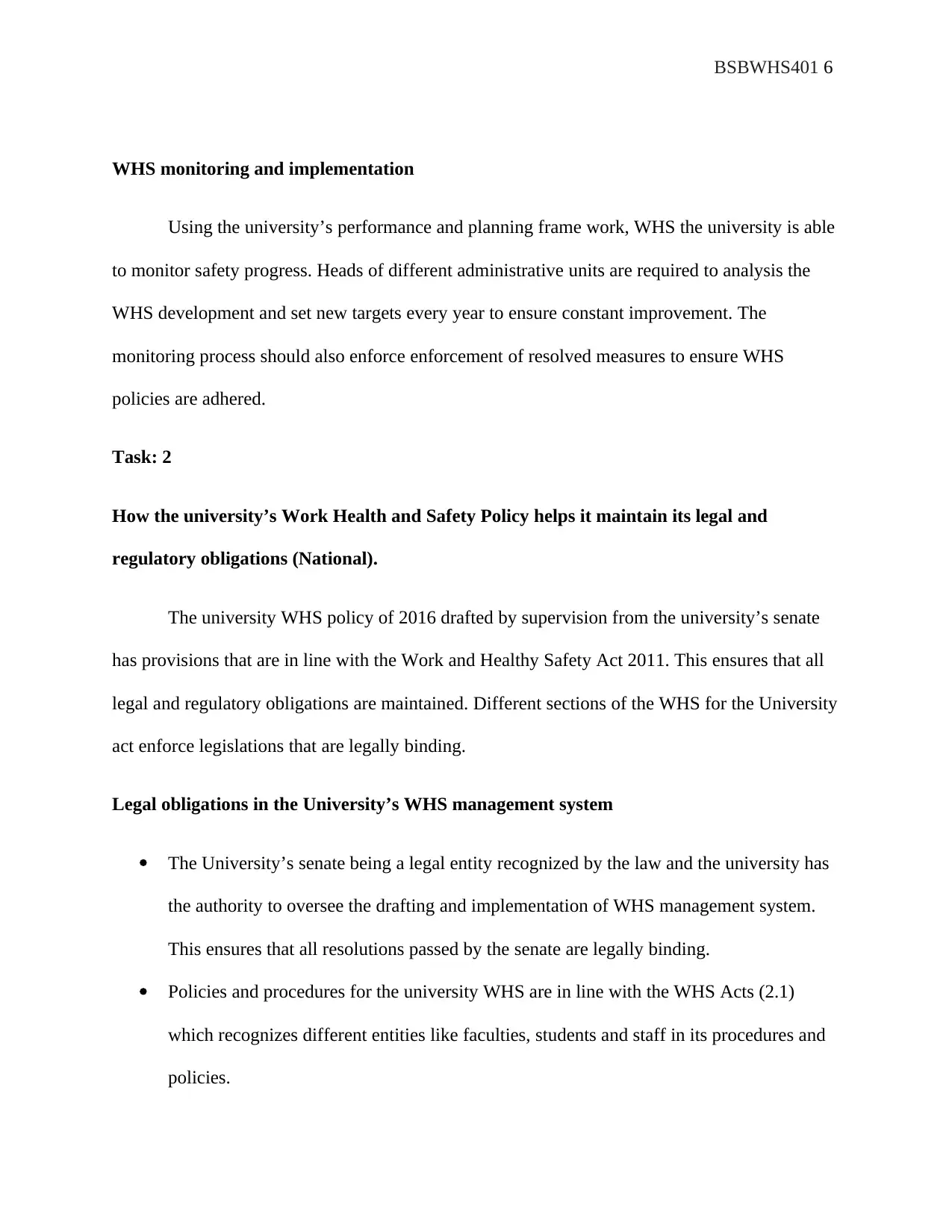
BSBWHS401 6
WHS monitoring and implementation
Using the university’s performance and planning frame work, WHS the university is able
to monitor safety progress. Heads of different administrative units are required to analysis the
WHS development and set new targets every year to ensure constant improvement. The
monitoring process should also enforce enforcement of resolved measures to ensure WHS
policies are adhered.
Task: 2
How the university’s Work Health and Safety Policy helps it maintain its legal and
regulatory obligations (National).
The university WHS policy of 2016 drafted by supervision from the university’s senate
has provisions that are in line with the Work and Healthy Safety Act 2011. This ensures that all
legal and regulatory obligations are maintained. Different sections of the WHS for the University
act enforce legislations that are legally binding.
Legal obligations in the University’s WHS management system
The University’s senate being a legal entity recognized by the law and the university has
the authority to oversee the drafting and implementation of WHS management system.
This ensures that all resolutions passed by the senate are legally binding.
Policies and procedures for the university WHS are in line with the WHS Acts (2.1)
which recognizes different entities like faculties, students and staff in its procedures and
policies.
WHS monitoring and implementation
Using the university’s performance and planning frame work, WHS the university is able
to monitor safety progress. Heads of different administrative units are required to analysis the
WHS development and set new targets every year to ensure constant improvement. The
monitoring process should also enforce enforcement of resolved measures to ensure WHS
policies are adhered.
Task: 2
How the university’s Work Health and Safety Policy helps it maintain its legal and
regulatory obligations (National).
The university WHS policy of 2016 drafted by supervision from the university’s senate
has provisions that are in line with the Work and Healthy Safety Act 2011. This ensures that all
legal and regulatory obligations are maintained. Different sections of the WHS for the University
act enforce legislations that are legally binding.
Legal obligations in the University’s WHS management system
The University’s senate being a legal entity recognized by the law and the university has
the authority to oversee the drafting and implementation of WHS management system.
This ensures that all resolutions passed by the senate are legally binding.
Policies and procedures for the university WHS are in line with the WHS Acts (2.1)
which recognizes different entities like faculties, students and staff in its procedures and
policies.
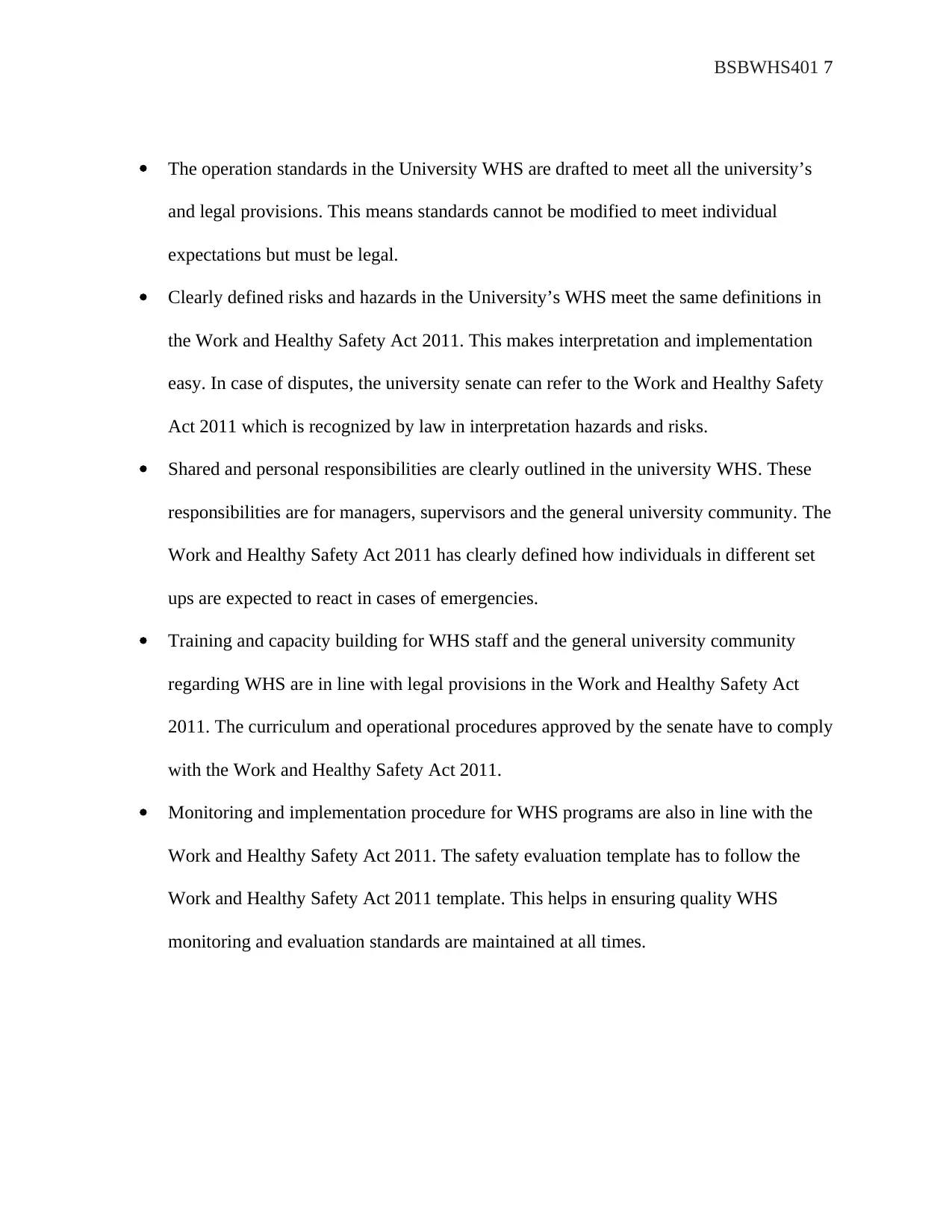
BSBWHS401 7
The operation standards in the University WHS are drafted to meet all the university’s
and legal provisions. This means standards cannot be modified to meet individual
expectations but must be legal.
Clearly defined risks and hazards in the University’s WHS meet the same definitions in
the Work and Healthy Safety Act 2011. This makes interpretation and implementation
easy. In case of disputes, the university senate can refer to the Work and Healthy Safety
Act 2011 which is recognized by law in interpretation hazards and risks.
Shared and personal responsibilities are clearly outlined in the university WHS. These
responsibilities are for managers, supervisors and the general university community. The
Work and Healthy Safety Act 2011 has clearly defined how individuals in different set
ups are expected to react in cases of emergencies.
Training and capacity building for WHS staff and the general university community
regarding WHS are in line with legal provisions in the Work and Healthy Safety Act
2011. The curriculum and operational procedures approved by the senate have to comply
with the Work and Healthy Safety Act 2011.
Monitoring and implementation procedure for WHS programs are also in line with the
Work and Healthy Safety Act 2011. The safety evaluation template has to follow the
Work and Healthy Safety Act 2011 template. This helps in ensuring quality WHS
monitoring and evaluation standards are maintained at all times.
The operation standards in the University WHS are drafted to meet all the university’s
and legal provisions. This means standards cannot be modified to meet individual
expectations but must be legal.
Clearly defined risks and hazards in the University’s WHS meet the same definitions in
the Work and Healthy Safety Act 2011. This makes interpretation and implementation
easy. In case of disputes, the university senate can refer to the Work and Healthy Safety
Act 2011 which is recognized by law in interpretation hazards and risks.
Shared and personal responsibilities are clearly outlined in the university WHS. These
responsibilities are for managers, supervisors and the general university community. The
Work and Healthy Safety Act 2011 has clearly defined how individuals in different set
ups are expected to react in cases of emergencies.
Training and capacity building for WHS staff and the general university community
regarding WHS are in line with legal provisions in the Work and Healthy Safety Act
2011. The curriculum and operational procedures approved by the senate have to comply
with the Work and Healthy Safety Act 2011.
Monitoring and implementation procedure for WHS programs are also in line with the
Work and Healthy Safety Act 2011. The safety evaluation template has to follow the
Work and Healthy Safety Act 2011 template. This helps in ensuring quality WHS
monitoring and evaluation standards are maintained at all times.
Paraphrase This Document
Need a fresh take? Get an instant paraphrase of this document with our AI Paraphraser
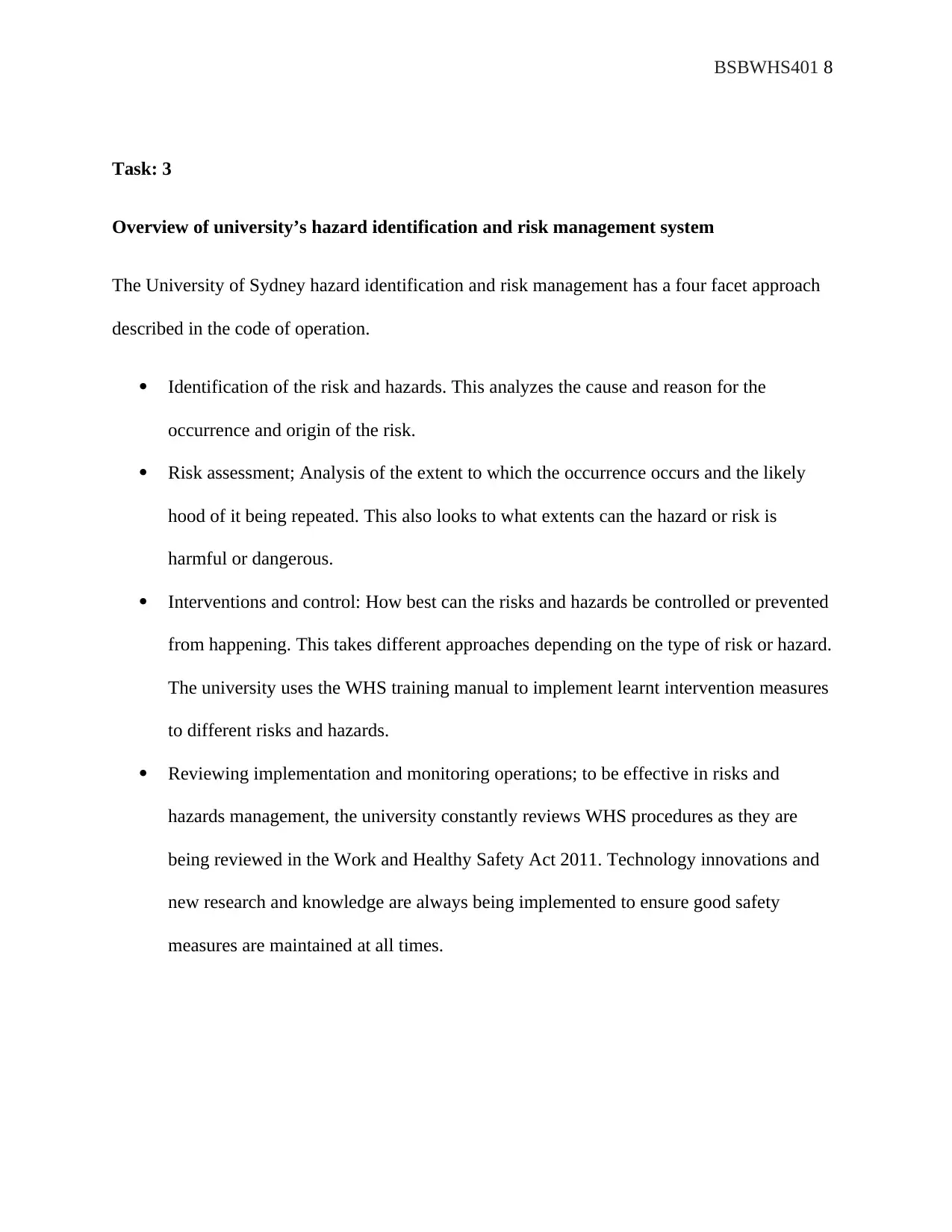
BSBWHS401 8
Task: 3
Overview of university’s hazard identification and risk management system
The University of Sydney hazard identification and risk management has a four facet approach
described in the code of operation.
Identification of the risk and hazards. This analyzes the cause and reason for the
occurrence and origin of the risk.
Risk assessment; Analysis of the extent to which the occurrence occurs and the likely
hood of it being repeated. This also looks to what extents can the hazard or risk is
harmful or dangerous.
Interventions and control: How best can the risks and hazards be controlled or prevented
from happening. This takes different approaches depending on the type of risk or hazard.
The university uses the WHS training manual to implement learnt intervention measures
to different risks and hazards.
Reviewing implementation and monitoring operations; to be effective in risks and
hazards management, the university constantly reviews WHS procedures as they are
being reviewed in the Work and Healthy Safety Act 2011. Technology innovations and
new research and knowledge are always being implemented to ensure good safety
measures are maintained at all times.
Task: 3
Overview of university’s hazard identification and risk management system
The University of Sydney hazard identification and risk management has a four facet approach
described in the code of operation.
Identification of the risk and hazards. This analyzes the cause and reason for the
occurrence and origin of the risk.
Risk assessment; Analysis of the extent to which the occurrence occurs and the likely
hood of it being repeated. This also looks to what extents can the hazard or risk is
harmful or dangerous.
Interventions and control: How best can the risks and hazards be controlled or prevented
from happening. This takes different approaches depending on the type of risk or hazard.
The university uses the WHS training manual to implement learnt intervention measures
to different risks and hazards.
Reviewing implementation and monitoring operations; to be effective in risks and
hazards management, the university constantly reviews WHS procedures as they are
being reviewed in the Work and Healthy Safety Act 2011. Technology innovations and
new research and knowledge are always being implemented to ensure good safety
measures are maintained at all times.
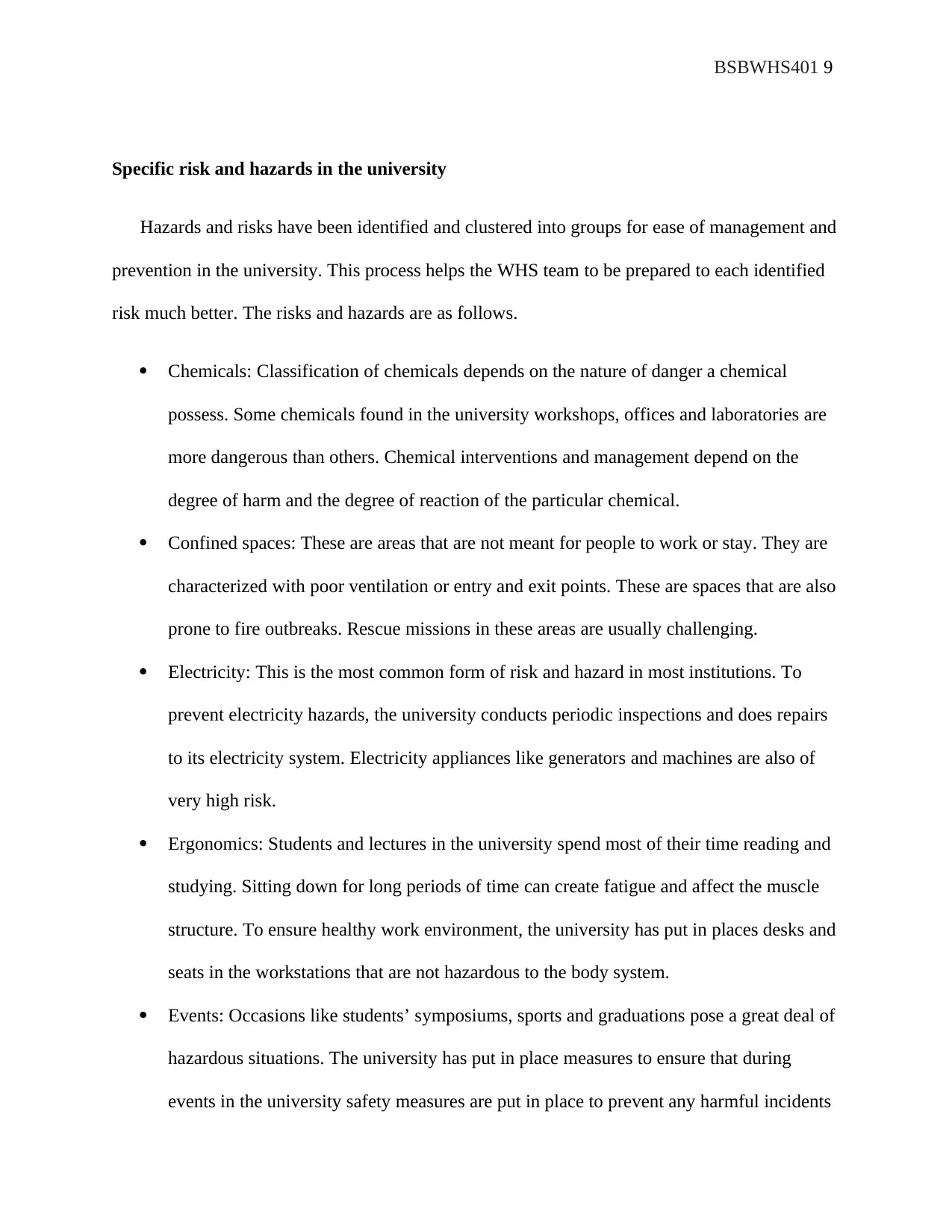
BSBWHS401 9
Specific risk and hazards in the university
Hazards and risks have been identified and clustered into groups for ease of management and
prevention in the university. This process helps the WHS team to be prepared to each identified
risk much better. The risks and hazards are as follows.
Chemicals: Classification of chemicals depends on the nature of danger a chemical
possess. Some chemicals found in the university workshops, offices and laboratories are
more dangerous than others. Chemical interventions and management depend on the
degree of harm and the degree of reaction of the particular chemical.
Confined spaces: These are areas that are not meant for people to work or stay. They are
characterized with poor ventilation or entry and exit points. These are spaces that are also
prone to fire outbreaks. Rescue missions in these areas are usually challenging.
Electricity: This is the most common form of risk and hazard in most institutions. To
prevent electricity hazards, the university conducts periodic inspections and does repairs
to its electricity system. Electricity appliances like generators and machines are also of
very high risk.
Ergonomics: Students and lectures in the university spend most of their time reading and
studying. Sitting down for long periods of time can create fatigue and affect the muscle
structure. To ensure healthy work environment, the university has put in places desks and
seats in the workstations that are not hazardous to the body system.
Events: Occasions like students’ symposiums, sports and graduations pose a great deal of
hazardous situations. The university has put in place measures to ensure that during
events in the university safety measures are put in place to prevent any harmful incidents
Specific risk and hazards in the university
Hazards and risks have been identified and clustered into groups for ease of management and
prevention in the university. This process helps the WHS team to be prepared to each identified
risk much better. The risks and hazards are as follows.
Chemicals: Classification of chemicals depends on the nature of danger a chemical
possess. Some chemicals found in the university workshops, offices and laboratories are
more dangerous than others. Chemical interventions and management depend on the
degree of harm and the degree of reaction of the particular chemical.
Confined spaces: These are areas that are not meant for people to work or stay. They are
characterized with poor ventilation or entry and exit points. These are spaces that are also
prone to fire outbreaks. Rescue missions in these areas are usually challenging.
Electricity: This is the most common form of risk and hazard in most institutions. To
prevent electricity hazards, the university conducts periodic inspections and does repairs
to its electricity system. Electricity appliances like generators and machines are also of
very high risk.
Ergonomics: Students and lectures in the university spend most of their time reading and
studying. Sitting down for long periods of time can create fatigue and affect the muscle
structure. To ensure healthy work environment, the university has put in places desks and
seats in the workstations that are not hazardous to the body system.
Events: Occasions like students’ symposiums, sports and graduations pose a great deal of
hazardous situations. The university has put in place measures to ensure that during
events in the university safety measures are put in place to prevent any harmful incidents
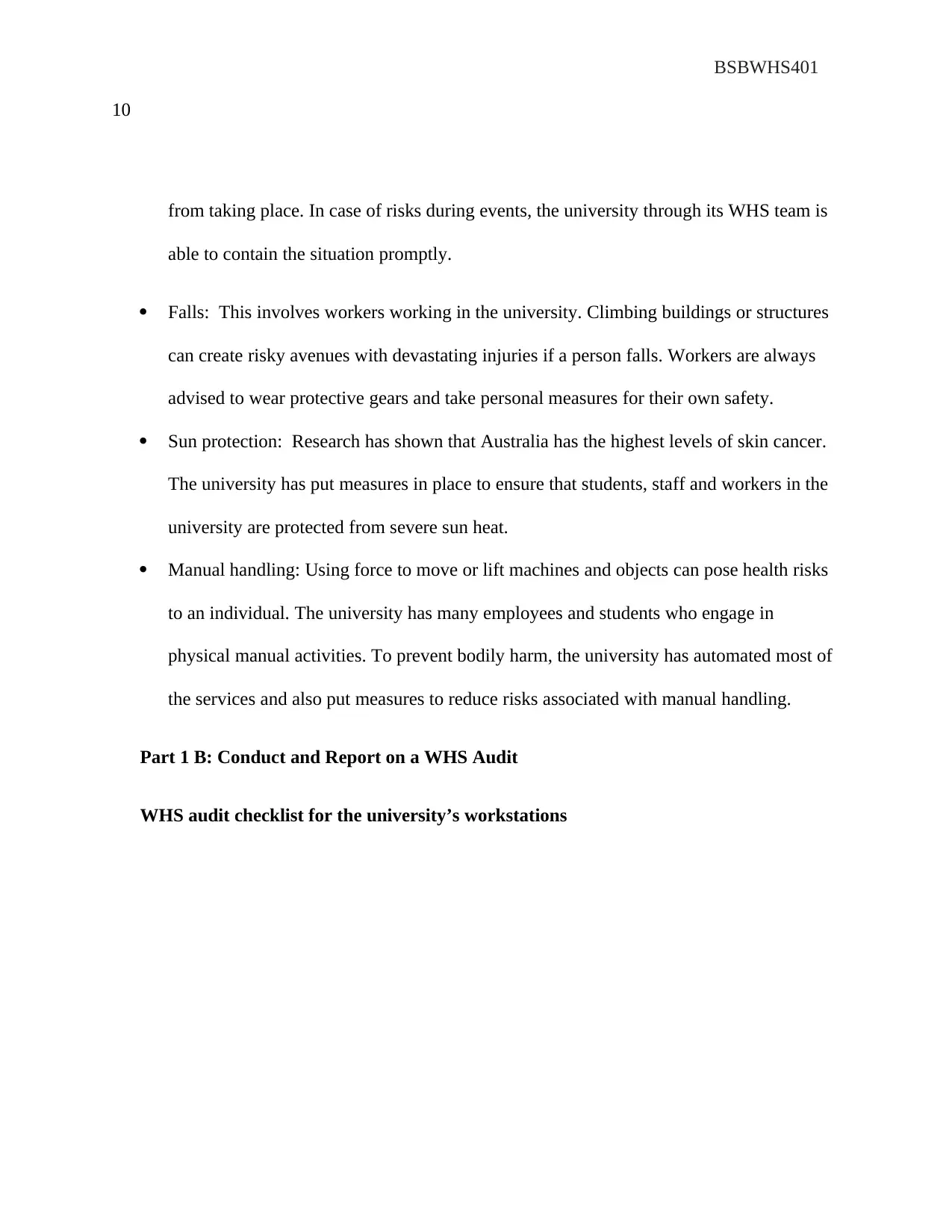
BSBWHS401
10
from taking place. In case of risks during events, the university through its WHS team is
able to contain the situation promptly.
Falls: This involves workers working in the university. Climbing buildings or structures
can create risky avenues with devastating injuries if a person falls. Workers are always
advised to wear protective gears and take personal measures for their own safety.
Sun protection: Research has shown that Australia has the highest levels of skin cancer.
The university has put measures in place to ensure that students, staff and workers in the
university are protected from severe sun heat.
Manual handling: Using force to move or lift machines and objects can pose health risks
to an individual. The university has many employees and students who engage in
physical manual activities. To prevent bodily harm, the university has automated most of
the services and also put measures to reduce risks associated with manual handling.
Part 1 B: Conduct and Report on a WHS Audit
WHS audit checklist for the university’s workstations
10
from taking place. In case of risks during events, the university through its WHS team is
able to contain the situation promptly.
Falls: This involves workers working in the university. Climbing buildings or structures
can create risky avenues with devastating injuries if a person falls. Workers are always
advised to wear protective gears and take personal measures for their own safety.
Sun protection: Research has shown that Australia has the highest levels of skin cancer.
The university has put measures in place to ensure that students, staff and workers in the
university are protected from severe sun heat.
Manual handling: Using force to move or lift machines and objects can pose health risks
to an individual. The university has many employees and students who engage in
physical manual activities. To prevent bodily harm, the university has automated most of
the services and also put measures to reduce risks associated with manual handling.
Part 1 B: Conduct and Report on a WHS Audit
WHS audit checklist for the university’s workstations
Secure Best Marks with AI Grader
Need help grading? Try our AI Grader for instant feedback on your assignments.

BSBWHS401
11
Part B Report on WHS audit
WORKPLACE INSPECTION CHECKLIST
The following is not an exhaustive list but a framework to guide workplace inspections. Each workplace may
wish to develop a site specific checklist. For review of workplace safety systems use the OHS self
assessment tool.
Team Members:
________________________________________________________________________________________
Date of Inspection:
______________________________________________________________________________________
Location (e.g. General Assistant’s Area/Workroom/Art room):
____________________________________________________
* Further action required: (i) Risk Management Plan (ii) Hazard Report form (iii) Incident Investigation (iv)
Other
Acceptable Immediate
action
taken
Further
action
required*
Date
signed
off
Date to be
completedY N
Thoroughfares (access and egress)
Pathways/walkways/stairs/ramps and access areas clear
of rubbish and obstructions
N Cleaning
them from
time to time
Ensuing
the areas
are free of
rubbish
and
obstructio
n
2-06-
2018
Pathways/walkways are slip free. Surfaces are even, free
of holes, cracks, fraying or uplifted edges
Y
Slip resistant materials or absorbent mats used in wet
areas
Y
Steps/stairs/ramps/handrails are secure and in good
repair
Y
Electrical cables/cords kept clear of walkways or secured Y
Exit and egress points clearly identified and accessible Y
Other: Y
11
Part B Report on WHS audit
WORKPLACE INSPECTION CHECKLIST
The following is not an exhaustive list but a framework to guide workplace inspections. Each workplace may
wish to develop a site specific checklist. For review of workplace safety systems use the OHS self
assessment tool.
Team Members:
________________________________________________________________________________________
Date of Inspection:
______________________________________________________________________________________
Location (e.g. General Assistant’s Area/Workroom/Art room):
____________________________________________________
* Further action required: (i) Risk Management Plan (ii) Hazard Report form (iii) Incident Investigation (iv)
Other
Acceptable Immediate
action
taken
Further
action
required*
Date
signed
off
Date to be
completedY N
Thoroughfares (access and egress)
Pathways/walkways/stairs/ramps and access areas clear
of rubbish and obstructions
N Cleaning
them from
time to time
Ensuing
the areas
are free of
rubbish
and
obstructio
n
2-06-
2018
Pathways/walkways are slip free. Surfaces are even, free
of holes, cracks, fraying or uplifted edges
Y
Slip resistant materials or absorbent mats used in wet
areas
Y
Steps/stairs/ramps/handrails are secure and in good
repair
Y
Electrical cables/cords kept clear of walkways or secured Y
Exit and egress points clearly identified and accessible Y
Other: Y
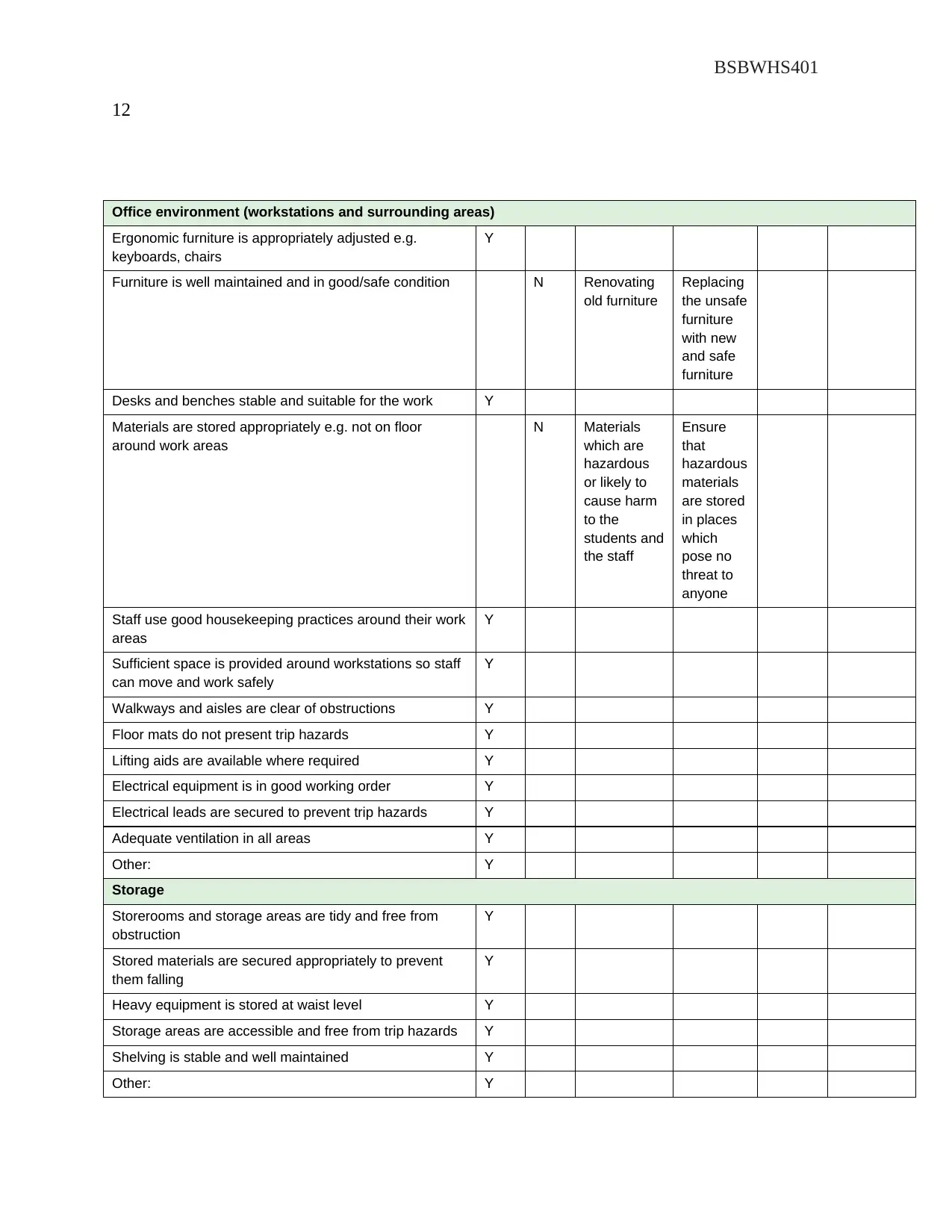
BSBWHS401
12
Office environment (workstations and surrounding areas)
Ergonomic furniture is appropriately adjusted e.g.
keyboards, chairs
Y
Furniture is well maintained and in good/safe condition N Renovating
old furniture
Replacing
the unsafe
furniture
with new
and safe
furniture
Desks and benches stable and suitable for the work Y
Materials are stored appropriately e.g. not on floor
around work areas
N Materials
which are
hazardous
or likely to
cause harm
to the
students and
the staff
Ensure
that
hazardous
materials
are stored
in places
which
pose no
threat to
anyone
Staff use good housekeeping practices around their work
areas
Y
Sufficient space is provided around workstations so staff
can move and work safely
Y
Walkways and aisles are clear of obstructions Y
Floor mats do not present trip hazards Y
Lifting aids are available where required Y
Electrical equipment is in good working order Y
Electrical leads are secured to prevent trip hazards Y
Adequate ventilation in all areas Y
Other: Y
Storage
Storerooms and storage areas are tidy and free from
obstruction
Y
Stored materials are secured appropriately to prevent
them falling
Y
Heavy equipment is stored at waist level Y
Storage areas are accessible and free from trip hazards Y
Shelving is stable and well maintained Y
Other: Y
12
Office environment (workstations and surrounding areas)
Ergonomic furniture is appropriately adjusted e.g.
keyboards, chairs
Y
Furniture is well maintained and in good/safe condition N Renovating
old furniture
Replacing
the unsafe
furniture
with new
and safe
furniture
Desks and benches stable and suitable for the work Y
Materials are stored appropriately e.g. not on floor
around work areas
N Materials
which are
hazardous
or likely to
cause harm
to the
students and
the staff
Ensure
that
hazardous
materials
are stored
in places
which
pose no
threat to
anyone
Staff use good housekeeping practices around their work
areas
Y
Sufficient space is provided around workstations so staff
can move and work safely
Y
Walkways and aisles are clear of obstructions Y
Floor mats do not present trip hazards Y
Lifting aids are available where required Y
Electrical equipment is in good working order Y
Electrical leads are secured to prevent trip hazards Y
Adequate ventilation in all areas Y
Other: Y
Storage
Storerooms and storage areas are tidy and free from
obstruction
Y
Stored materials are secured appropriately to prevent
them falling
Y
Heavy equipment is stored at waist level Y
Storage areas are accessible and free from trip hazards Y
Shelving is stable and well maintained Y
Other: Y

BSBWHS401
13
Acceptable Immediate
action
taken
Further
action
required*
Date
signed
off
Date to be
completedY N
Electrical
All power boards have an overload switch Y
Portable power leakage circuits checked and functioning
correctly
Y
All electrical cables free of possible contact with water or
other conductors
Y
Double adaptors are not used in conjunction with other
double adaptors or extension leads
Y
No leads placed where subject to damage e.g. heat or
cutting
Y
No broken plugs, sockets or switches Y
Other: Y
Master controls – whole workplace
Perimeter fences and safety barriers in place and
maintained
Y
Access by delivery vehicles and other vehicles safe for
pedestrians
Y
Rubbish is stored appropriately and removed regularly Y
Building/renovation areas and contained debris are
controlled through effective barriers against unauthorised
access
Y
Other: Y
Bathrooms and toilets
Adequate and clean toilet facilities and supplies Y
Toilets provided for people with disability Y
Toilet and bathroom facilities cleaned regularly Y
Paper towels or air dryers available and working Y
Toilet paper available with spare rolls readily accessible Y
Sanitary towel disposal units in female toilets Y
Facilities well ventilated Y
Other: Y
Canteen
Appropriate hand washing facilities are available Y
13
Acceptable Immediate
action
taken
Further
action
required*
Date
signed
off
Date to be
completedY N
Electrical
All power boards have an overload switch Y
Portable power leakage circuits checked and functioning
correctly
Y
All electrical cables free of possible contact with water or
other conductors
Y
Double adaptors are not used in conjunction with other
double adaptors or extension leads
Y
No leads placed where subject to damage e.g. heat or
cutting
Y
No broken plugs, sockets or switches Y
Other: Y
Master controls – whole workplace
Perimeter fences and safety barriers in place and
maintained
Y
Access by delivery vehicles and other vehicles safe for
pedestrians
Y
Rubbish is stored appropriately and removed regularly Y
Building/renovation areas and contained debris are
controlled through effective barriers against unauthorised
access
Y
Other: Y
Bathrooms and toilets
Adequate and clean toilet facilities and supplies Y
Toilets provided for people with disability Y
Toilet and bathroom facilities cleaned regularly Y
Paper towels or air dryers available and working Y
Toilet paper available with spare rolls readily accessible Y
Sanitary towel disposal units in female toilets Y
Facilities well ventilated Y
Other: Y
Canteen
Appropriate hand washing facilities are available Y
Paraphrase This Document
Need a fresh take? Get an instant paraphrase of this document with our AI Paraphraser
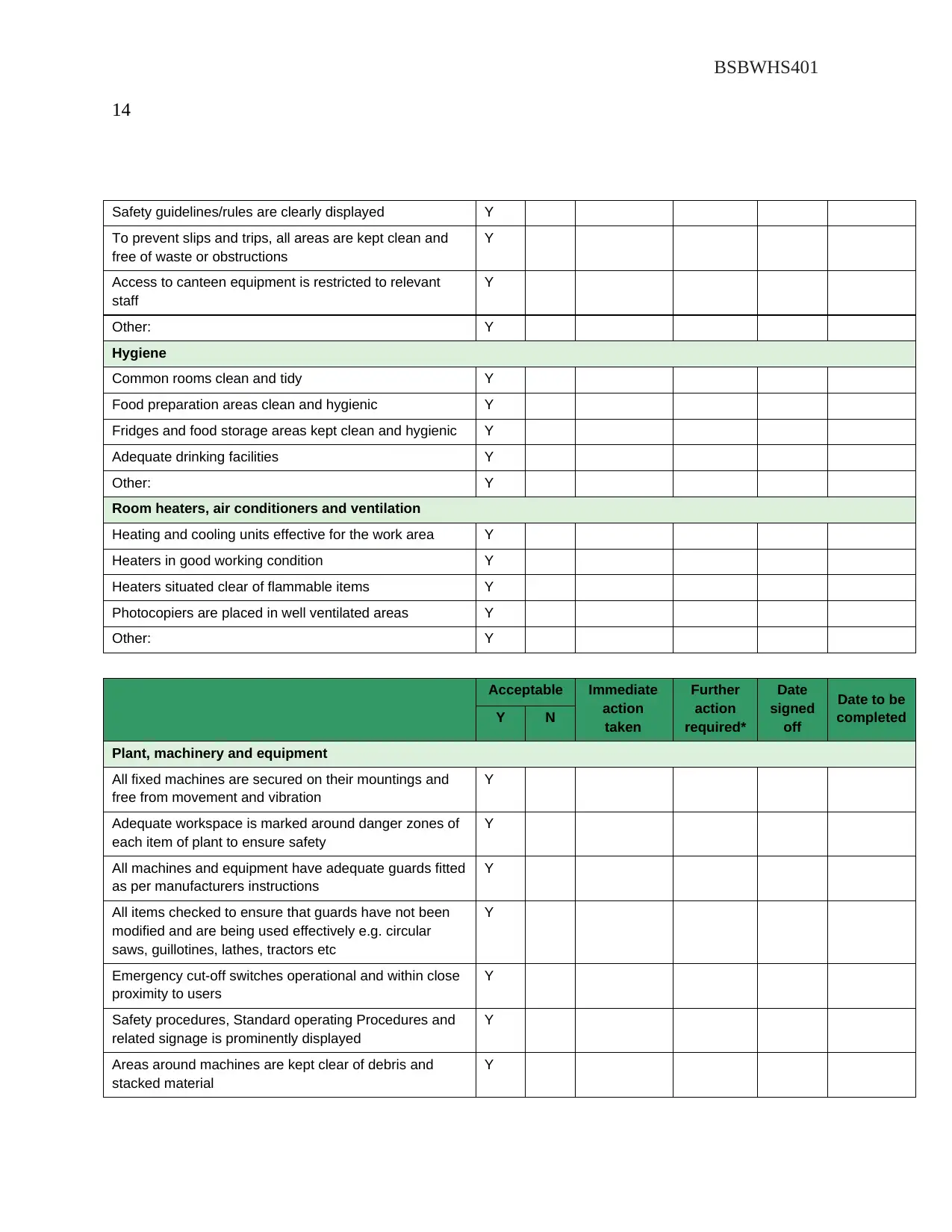
BSBWHS401
14
Safety guidelines/rules are clearly displayed Y
To prevent slips and trips, all areas are kept clean and
free of waste or obstructions
Y
Access to canteen equipment is restricted to relevant
staff
Y
Other: Y
Hygiene
Common rooms clean and tidy Y
Food preparation areas clean and hygienic Y
Fridges and food storage areas kept clean and hygienic Y
Adequate drinking facilities Y
Other: Y
Room heaters, air conditioners and ventilation
Heating and cooling units effective for the work area Y
Heaters in good working condition Y
Heaters situated clear of flammable items Y
Photocopiers are placed in well ventilated areas Y
Other: Y
Acceptable Immediate
action
taken
Further
action
required*
Date
signed
off
Date to be
completedY N
Plant, machinery and equipment
All fixed machines are secured on their mountings and
free from movement and vibration
Y
Adequate workspace is marked around danger zones of
each item of plant to ensure safety
Y
All machines and equipment have adequate guards fitted
as per manufacturers instructions
Y
All items checked to ensure that guards have not been
modified and are being used effectively e.g. circular
saws, guillotines, lathes, tractors etc
Y
Emergency cut-off switches operational and within close
proximity to users
Y
Safety procedures, Standard operating Procedures and
related signage is prominently displayed
Y
Areas around machines are kept clear of debris and
stacked material
Y
14
Safety guidelines/rules are clearly displayed Y
To prevent slips and trips, all areas are kept clean and
free of waste or obstructions
Y
Access to canteen equipment is restricted to relevant
staff
Y
Other: Y
Hygiene
Common rooms clean and tidy Y
Food preparation areas clean and hygienic Y
Fridges and food storage areas kept clean and hygienic Y
Adequate drinking facilities Y
Other: Y
Room heaters, air conditioners and ventilation
Heating and cooling units effective for the work area Y
Heaters in good working condition Y
Heaters situated clear of flammable items Y
Photocopiers are placed in well ventilated areas Y
Other: Y
Acceptable Immediate
action
taken
Further
action
required*
Date
signed
off
Date to be
completedY N
Plant, machinery and equipment
All fixed machines are secured on their mountings and
free from movement and vibration
Y
Adequate workspace is marked around danger zones of
each item of plant to ensure safety
Y
All machines and equipment have adequate guards fitted
as per manufacturers instructions
Y
All items checked to ensure that guards have not been
modified and are being used effectively e.g. circular
saws, guillotines, lathes, tractors etc
Y
Emergency cut-off switches operational and within close
proximity to users
Y
Safety procedures, Standard operating Procedures and
related signage is prominently displayed
Y
Areas around machines are kept clear of debris and
stacked material
Y
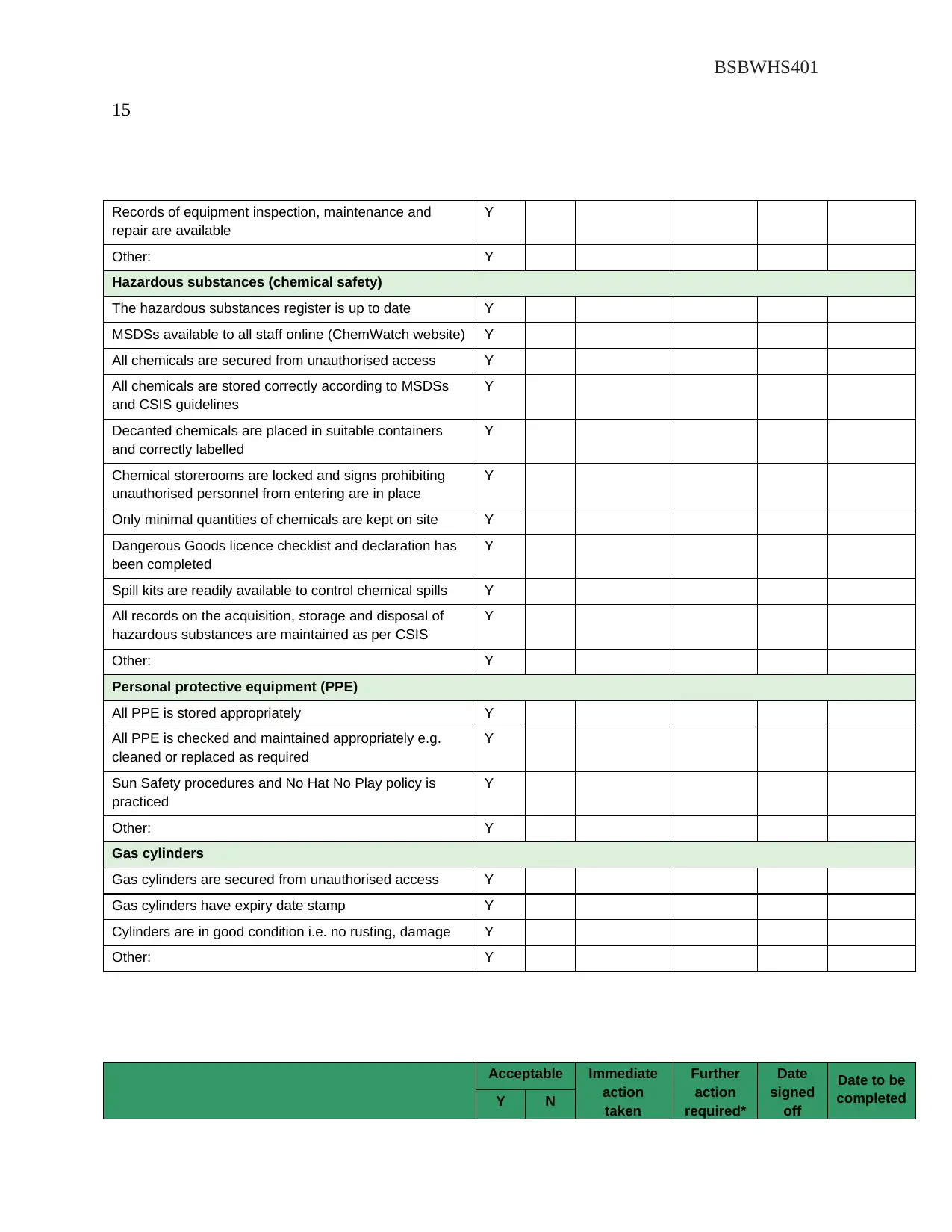
BSBWHS401
15
Records of equipment inspection, maintenance and
repair are available
Y
Other: Y
Hazardous substances (chemical safety)
The hazardous substances register is up to date Y
MSDSs available to all staff online (ChemWatch website) Y
All chemicals are secured from unauthorised access Y
All chemicals are stored correctly according to MSDSs
and CSIS guidelines
Y
Decanted chemicals are placed in suitable containers
and correctly labelled
Y
Chemical storerooms are locked and signs prohibiting
unauthorised personnel from entering are in place
Y
Only minimal quantities of chemicals are kept on site Y
Dangerous Goods licence checklist and declaration has
been completed
Y
Spill kits are readily available to control chemical spills Y
All records on the acquisition, storage and disposal of
hazardous substances are maintained as per CSIS
Y
Other: Y
Personal protective equipment (PPE)
All PPE is stored appropriately Y
All PPE is checked and maintained appropriately e.g.
cleaned or replaced as required
Y
Sun Safety procedures and No Hat No Play policy is
practiced
Y
Other: Y
Gas cylinders
Gas cylinders are secured from unauthorised access Y
Gas cylinders have expiry date stamp Y
Cylinders are in good condition i.e. no rusting, damage Y
Other: Y
Acceptable Immediate
action
taken
Further
action
required*
Date
signed
off
Date to be
completedY N
15
Records of equipment inspection, maintenance and
repair are available
Y
Other: Y
Hazardous substances (chemical safety)
The hazardous substances register is up to date Y
MSDSs available to all staff online (ChemWatch website) Y
All chemicals are secured from unauthorised access Y
All chemicals are stored correctly according to MSDSs
and CSIS guidelines
Y
Decanted chemicals are placed in suitable containers
and correctly labelled
Y
Chemical storerooms are locked and signs prohibiting
unauthorised personnel from entering are in place
Y
Only minimal quantities of chemicals are kept on site Y
Dangerous Goods licence checklist and declaration has
been completed
Y
Spill kits are readily available to control chemical spills Y
All records on the acquisition, storage and disposal of
hazardous substances are maintained as per CSIS
Y
Other: Y
Personal protective equipment (PPE)
All PPE is stored appropriately Y
All PPE is checked and maintained appropriately e.g.
cleaned or replaced as required
Y
Sun Safety procedures and No Hat No Play policy is
practiced
Y
Other: Y
Gas cylinders
Gas cylinders are secured from unauthorised access Y
Gas cylinders have expiry date stamp Y
Cylinders are in good condition i.e. no rusting, damage Y
Other: Y
Acceptable Immediate
action
taken
Further
action
required*
Date
signed
off
Date to be
completedY N
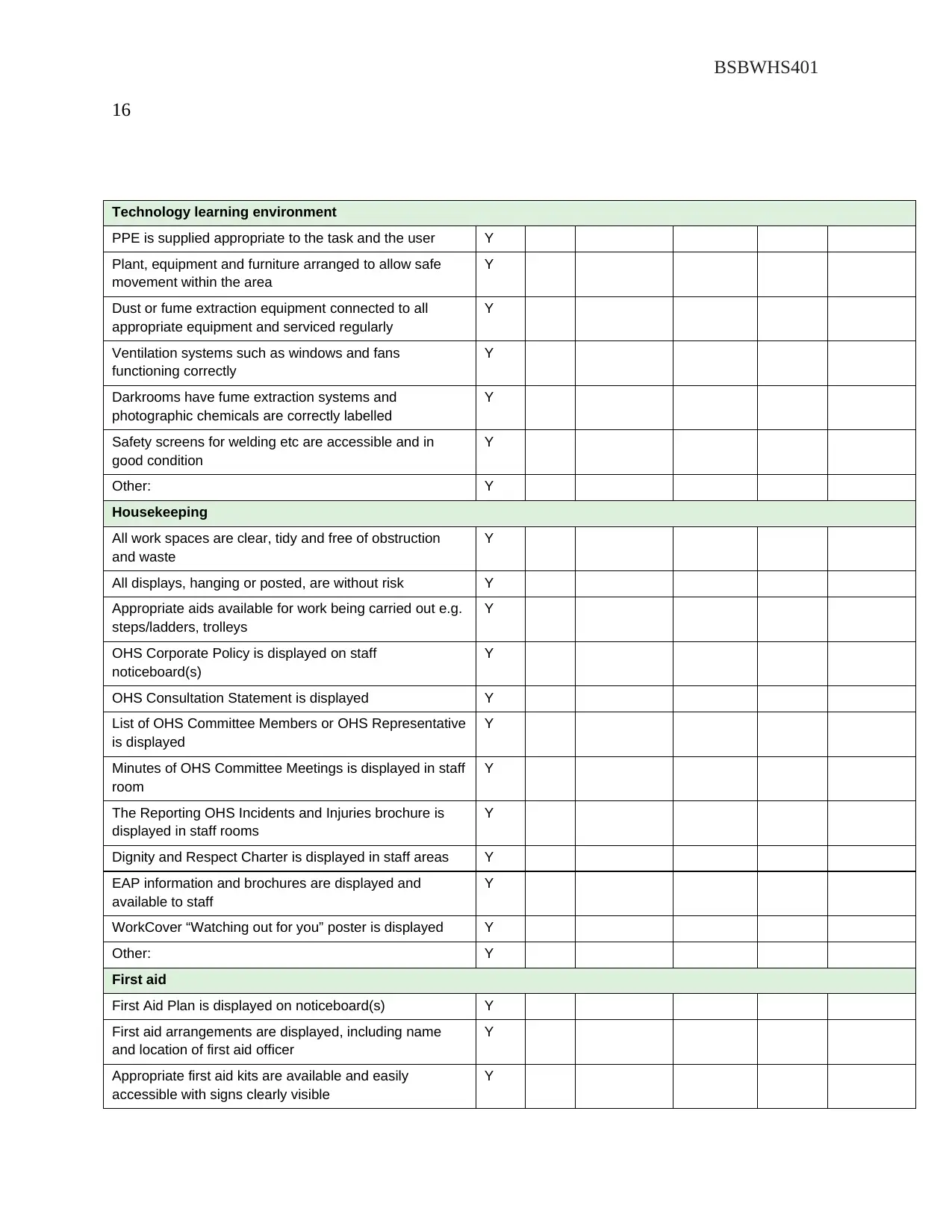
BSBWHS401
16
Technology learning environment
PPE is supplied appropriate to the task and the user Y
Plant, equipment and furniture arranged to allow safe
movement within the area
Y
Dust or fume extraction equipment connected to all
appropriate equipment and serviced regularly
Y
Ventilation systems such as windows and fans
functioning correctly
Y
Darkrooms have fume extraction systems and
photographic chemicals are correctly labelled
Y
Safety screens for welding etc are accessible and in
good condition
Y
Other: Y
Housekeeping
All work spaces are clear, tidy and free of obstruction
and waste
Y
All displays, hanging or posted, are without risk Y
Appropriate aids available for work being carried out e.g.
steps/ladders, trolleys
Y
OHS Corporate Policy is displayed on staff
noticeboard(s)
Y
OHS Consultation Statement is displayed Y
List of OHS Committee Members or OHS Representative
is displayed
Y
Minutes of OHS Committee Meetings is displayed in staff
room
Y
The Reporting OHS Incidents and Injuries brochure is
displayed in staff rooms
Y
Dignity and Respect Charter is displayed in staff areas Y
EAP information and brochures are displayed and
available to staff
Y
WorkCover “Watching out for you” poster is displayed Y
Other: Y
First aid
First Aid Plan is displayed on noticeboard(s) Y
First aid arrangements are displayed, including name
and location of first aid officer
Y
Appropriate first aid kits are available and easily
accessible with signs clearly visible
Y
16
Technology learning environment
PPE is supplied appropriate to the task and the user Y
Plant, equipment and furniture arranged to allow safe
movement within the area
Y
Dust or fume extraction equipment connected to all
appropriate equipment and serviced regularly
Y
Ventilation systems such as windows and fans
functioning correctly
Y
Darkrooms have fume extraction systems and
photographic chemicals are correctly labelled
Y
Safety screens for welding etc are accessible and in
good condition
Y
Other: Y
Housekeeping
All work spaces are clear, tidy and free of obstruction
and waste
Y
All displays, hanging or posted, are without risk Y
Appropriate aids available for work being carried out e.g.
steps/ladders, trolleys
Y
OHS Corporate Policy is displayed on staff
noticeboard(s)
Y
OHS Consultation Statement is displayed Y
List of OHS Committee Members or OHS Representative
is displayed
Y
Minutes of OHS Committee Meetings is displayed in staff
room
Y
The Reporting OHS Incidents and Injuries brochure is
displayed in staff rooms
Y
Dignity and Respect Charter is displayed in staff areas Y
EAP information and brochures are displayed and
available to staff
Y
WorkCover “Watching out for you” poster is displayed Y
Other: Y
First aid
First Aid Plan is displayed on noticeboard(s) Y
First aid arrangements are displayed, including name
and location of first aid officer
Y
Appropriate first aid kits are available and easily
accessible with signs clearly visible
Y
Secure Best Marks with AI Grader
Need help grading? Try our AI Grader for instant feedback on your assignments.
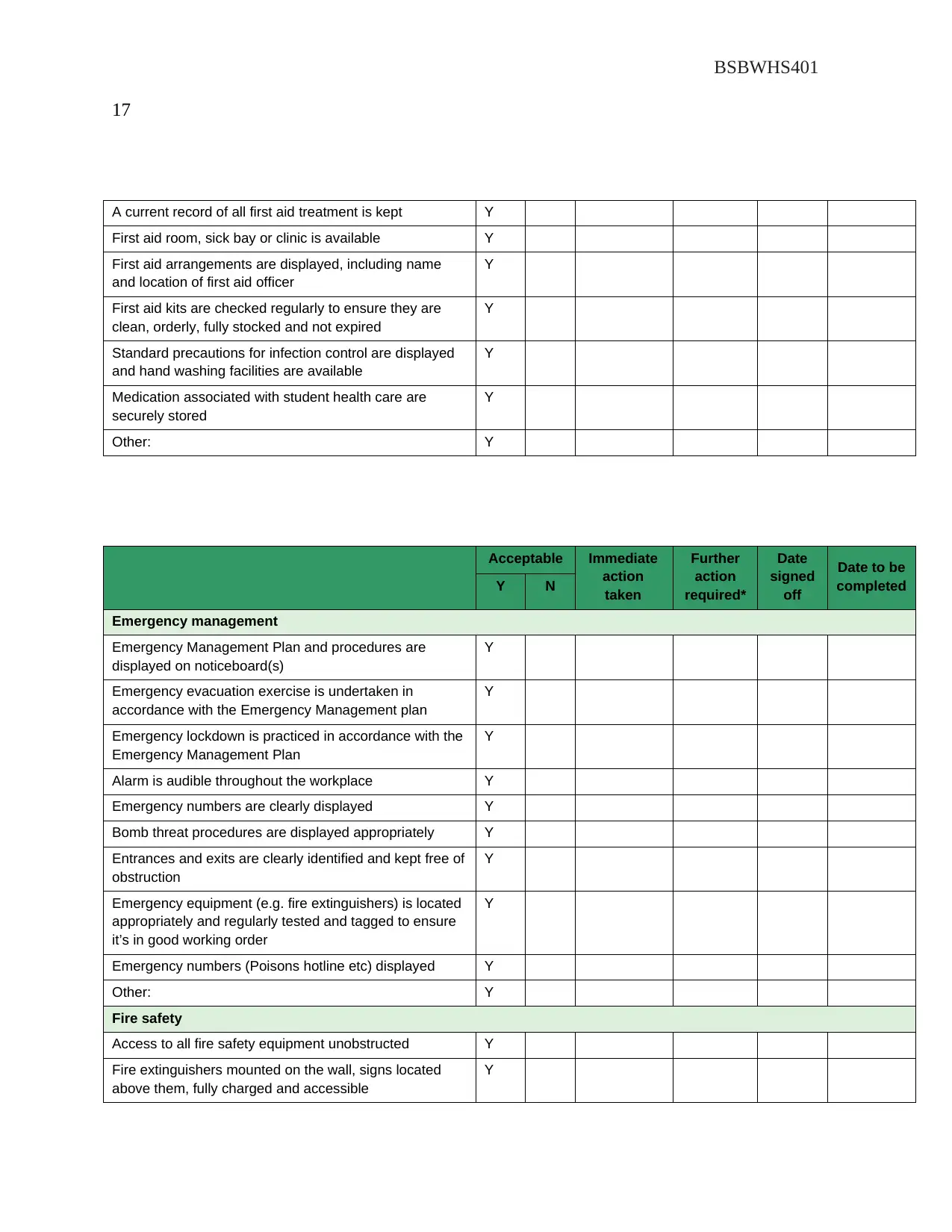
BSBWHS401
17
A current record of all first aid treatment is kept Y
First aid room, sick bay or clinic is available Y
First aid arrangements are displayed, including name
and location of first aid officer
Y
First aid kits are checked regularly to ensure they are
clean, orderly, fully stocked and not expired
Y
Standard precautions for infection control are displayed
and hand washing facilities are available
Y
Medication associated with student health care are
securely stored
Y
Other: Y
Acceptable Immediate
action
taken
Further
action
required*
Date
signed
off
Date to be
completedY N
Emergency management
Emergency Management Plan and procedures are
displayed on noticeboard(s)
Y
Emergency evacuation exercise is undertaken in
accordance with the Emergency Management plan
Y
Emergency lockdown is practiced in accordance with the
Emergency Management Plan
Y
Alarm is audible throughout the workplace Y
Emergency numbers are clearly displayed Y
Bomb threat procedures are displayed appropriately Y
Entrances and exits are clearly identified and kept free of
obstruction
Y
Emergency equipment (e.g. fire extinguishers) is located
appropriately and regularly tested and tagged to ensure
it’s in good working order
Y
Emergency numbers (Poisons hotline etc) displayed Y
Other: Y
Fire safety
Access to all fire safety equipment unobstructed Y
Fire extinguishers mounted on the wall, signs located
above them, fully charged and accessible
Y
17
A current record of all first aid treatment is kept Y
First aid room, sick bay or clinic is available Y
First aid arrangements are displayed, including name
and location of first aid officer
Y
First aid kits are checked regularly to ensure they are
clean, orderly, fully stocked and not expired
Y
Standard precautions for infection control are displayed
and hand washing facilities are available
Y
Medication associated with student health care are
securely stored
Y
Other: Y
Acceptable Immediate
action
taken
Further
action
required*
Date
signed
off
Date to be
completedY N
Emergency management
Emergency Management Plan and procedures are
displayed on noticeboard(s)
Y
Emergency evacuation exercise is undertaken in
accordance with the Emergency Management plan
Y
Emergency lockdown is practiced in accordance with the
Emergency Management Plan
Y
Alarm is audible throughout the workplace Y
Emergency numbers are clearly displayed Y
Bomb threat procedures are displayed appropriately Y
Entrances and exits are clearly identified and kept free of
obstruction
Y
Emergency equipment (e.g. fire extinguishers) is located
appropriately and regularly tested and tagged to ensure
it’s in good working order
Y
Emergency numbers (Poisons hotline etc) displayed Y
Other: Y
Fire safety
Access to all fire safety equipment unobstructed Y
Fire extinguishers mounted on the wall, signs located
above them, fully charged and accessible
Y
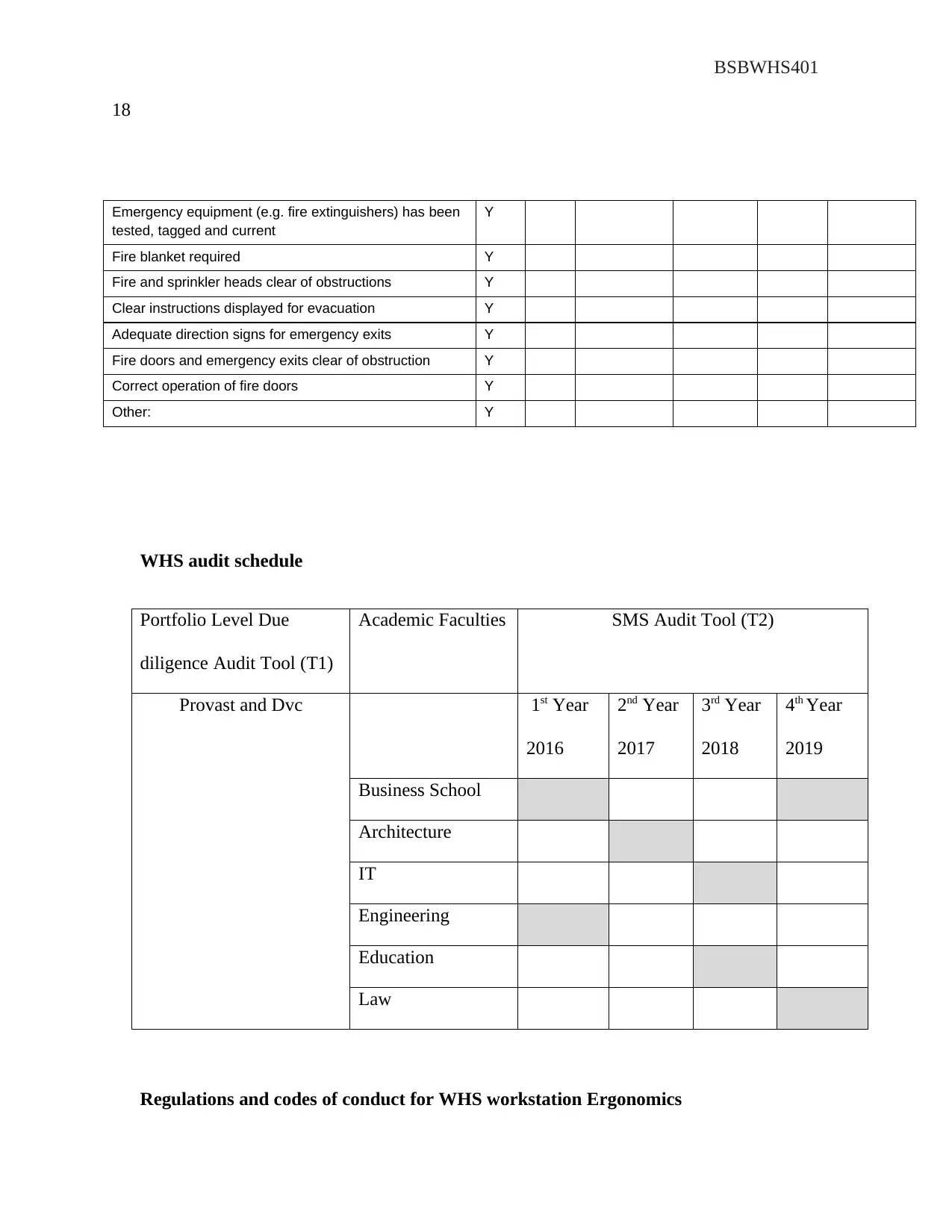
BSBWHS401
18
Emergency equipment (e.g. fire extinguishers) has been
tested, tagged and current
Y
Fire blanket required Y
Fire and sprinkler heads clear of obstructions Y
Clear instructions displayed for evacuation Y
Adequate direction signs for emergency exits Y
Fire doors and emergency exits clear of obstruction Y
Correct operation of fire doors Y
Other: Y
WHS audit schedule
Portfolio Level Due
diligence Audit Tool (T1)
Academic Faculties SMS Audit Tool (T2)
Provast and Dvc 1st Year
2016
2nd Year
2017
3rd Year
2018
4th Year
2019
Business School
Architecture
IT
Engineering
Education
Law
Regulations and codes of conduct for WHS workstation Ergonomics
18
Emergency equipment (e.g. fire extinguishers) has been
tested, tagged and current
Y
Fire blanket required Y
Fire and sprinkler heads clear of obstructions Y
Clear instructions displayed for evacuation Y
Adequate direction signs for emergency exits Y
Fire doors and emergency exits clear of obstruction Y
Correct operation of fire doors Y
Other: Y
WHS audit schedule
Portfolio Level Due
diligence Audit Tool (T1)
Academic Faculties SMS Audit Tool (T2)
Provast and Dvc 1st Year
2016
2nd Year
2017
3rd Year
2018
4th Year
2019
Business School
Architecture
IT
Engineering
Education
Law
Regulations and codes of conduct for WHS workstation Ergonomics

BSBWHS401
19
Regulation 40: The work environment and recommendations of measures in the audit
Individuals and WHS department must ensure that the workstation meets the following
guidelines in the work environment.
Entry and exit points: They must be easily accessible at all times by everyone in the
workstation. This will ensure ease of access to people by the rescue team in case of an
emergency. The doors should take into consideration people with special needs
requirements. Corridors should be 600mm wide and not have any items that can
prevent free movement of people. There should also be separate entry and exit points
for machines and heavy assets that is separate from the one used by students and staff.
Doors that use security codes and electricity should allow emergency response
buttons to alert administrators in case of power failure. The exit and entry doors
should be clearly indicated. This allows free movement of people without causing any
confusion during movement.
Floors and other surfaces: These must be made in a way that allows easy movement
of people in the work place. Floors should not be too slippery or very rough. Floors
should be inspected regularly and maintained in good conditions. Workers using
metallic or sharp pointed tools and machines should ensure that they protect the floor
surface’s they are working on to prevent damage. Offices should ensure if they are
able that floors are carpeted to aid in easy movement of people and to also reduce
noise generated from people walking and objects falling on the floor. Work stations
19
Regulation 40: The work environment and recommendations of measures in the audit
Individuals and WHS department must ensure that the workstation meets the following
guidelines in the work environment.
Entry and exit points: They must be easily accessible at all times by everyone in the
workstation. This will ensure ease of access to people by the rescue team in case of an
emergency. The doors should take into consideration people with special needs
requirements. Corridors should be 600mm wide and not have any items that can
prevent free movement of people. There should also be separate entry and exit points
for machines and heavy assets that is separate from the one used by students and staff.
Doors that use security codes and electricity should allow emergency response
buttons to alert administrators in case of power failure. The exit and entry doors
should be clearly indicated. This allows free movement of people without causing any
confusion during movement.
Floors and other surfaces: These must be made in a way that allows easy movement
of people in the work place. Floors should not be too slippery or very rough. Floors
should be inspected regularly and maintained in good conditions. Workers using
metallic or sharp pointed tools and machines should ensure that they protect the floor
surface’s they are working on to prevent damage. Offices should ensure if they are
able that floors are carpeted to aid in easy movement of people and to also reduce
noise generated from people walking and objects falling on the floor. Work stations
Paraphrase This Document
Need a fresh take? Get an instant paraphrase of this document with our AI Paraphraser
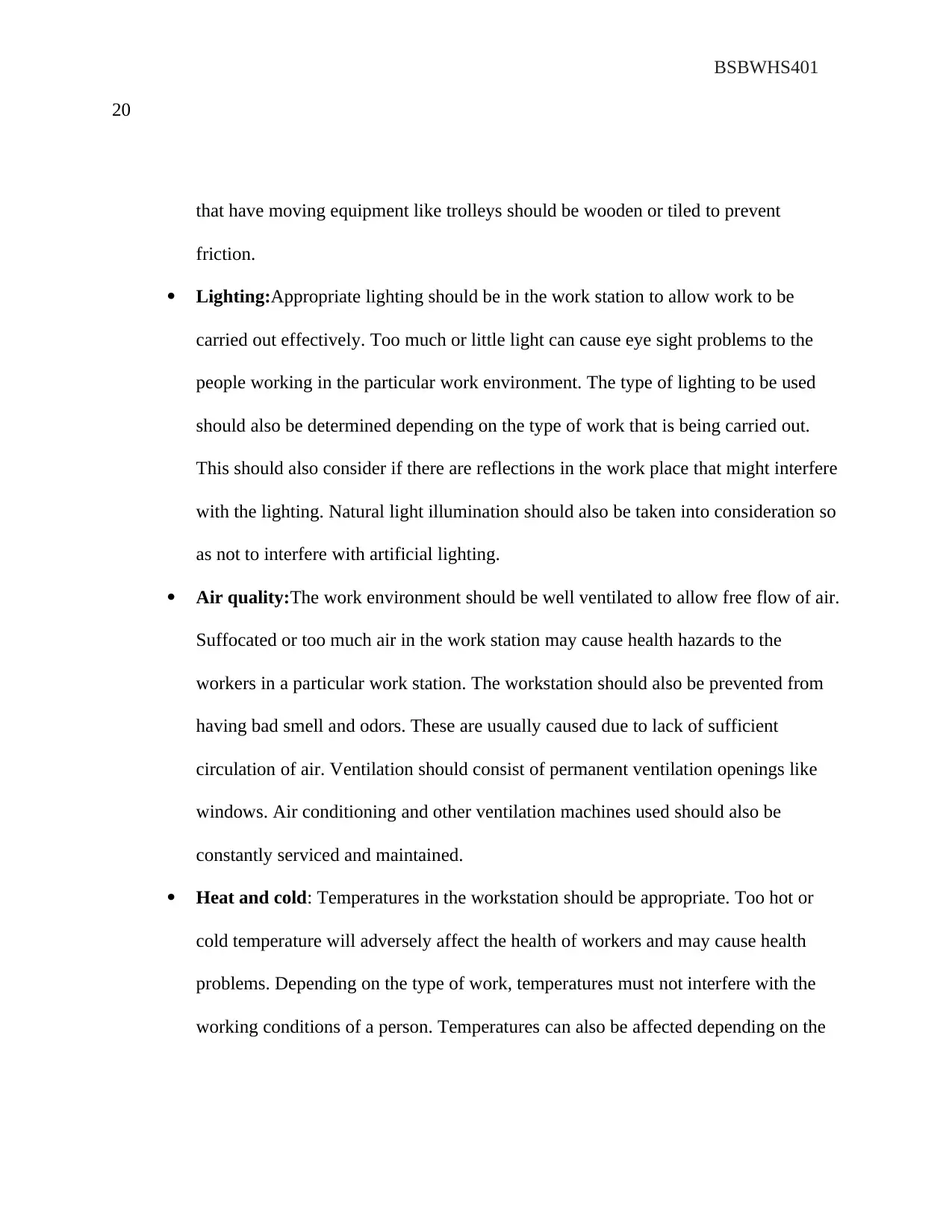
BSBWHS401
20
that have moving equipment like trolleys should be wooden or tiled to prevent
friction.
Lighting:Appropriate lighting should be in the work station to allow work to be
carried out effectively. Too much or little light can cause eye sight problems to the
people working in the particular work environment. The type of lighting to be used
should also be determined depending on the type of work that is being carried out.
This should also consider if there are reflections in the work place that might interfere
with the lighting. Natural light illumination should also be taken into consideration so
as not to interfere with artificial lighting.
Air quality:The work environment should be well ventilated to allow free flow of air.
Suffocated or too much air in the work station may cause health hazards to the
workers in a particular work station. The workstation should also be prevented from
having bad smell and odors. These are usually caused due to lack of sufficient
circulation of air. Ventilation should consist of permanent ventilation openings like
windows. Air conditioning and other ventilation machines used should also be
constantly serviced and maintained.
Heat and cold: Temperatures in the workstation should be appropriate. Too hot or
cold temperature will adversely affect the health of workers and may cause health
problems. Depending on the type of work, temperatures must not interfere with the
working conditions of a person. Temperatures can also be affected depending on the
20
that have moving equipment like trolleys should be wooden or tiled to prevent
friction.
Lighting:Appropriate lighting should be in the work station to allow work to be
carried out effectively. Too much or little light can cause eye sight problems to the
people working in the particular work environment. The type of lighting to be used
should also be determined depending on the type of work that is being carried out.
This should also consider if there are reflections in the work place that might interfere
with the lighting. Natural light illumination should also be taken into consideration so
as not to interfere with artificial lighting.
Air quality:The work environment should be well ventilated to allow free flow of air.
Suffocated or too much air in the work station may cause health hazards to the
workers in a particular work station. The workstation should also be prevented from
having bad smell and odors. These are usually caused due to lack of sufficient
circulation of air. Ventilation should consist of permanent ventilation openings like
windows. Air conditioning and other ventilation machines used should also be
constantly serviced and maintained.
Heat and cold: Temperatures in the workstation should be appropriate. Too hot or
cold temperature will adversely affect the health of workers and may cause health
problems. Depending on the type of work, temperatures must not interfere with the
working conditions of a person. Temperatures can also be affected depending on the
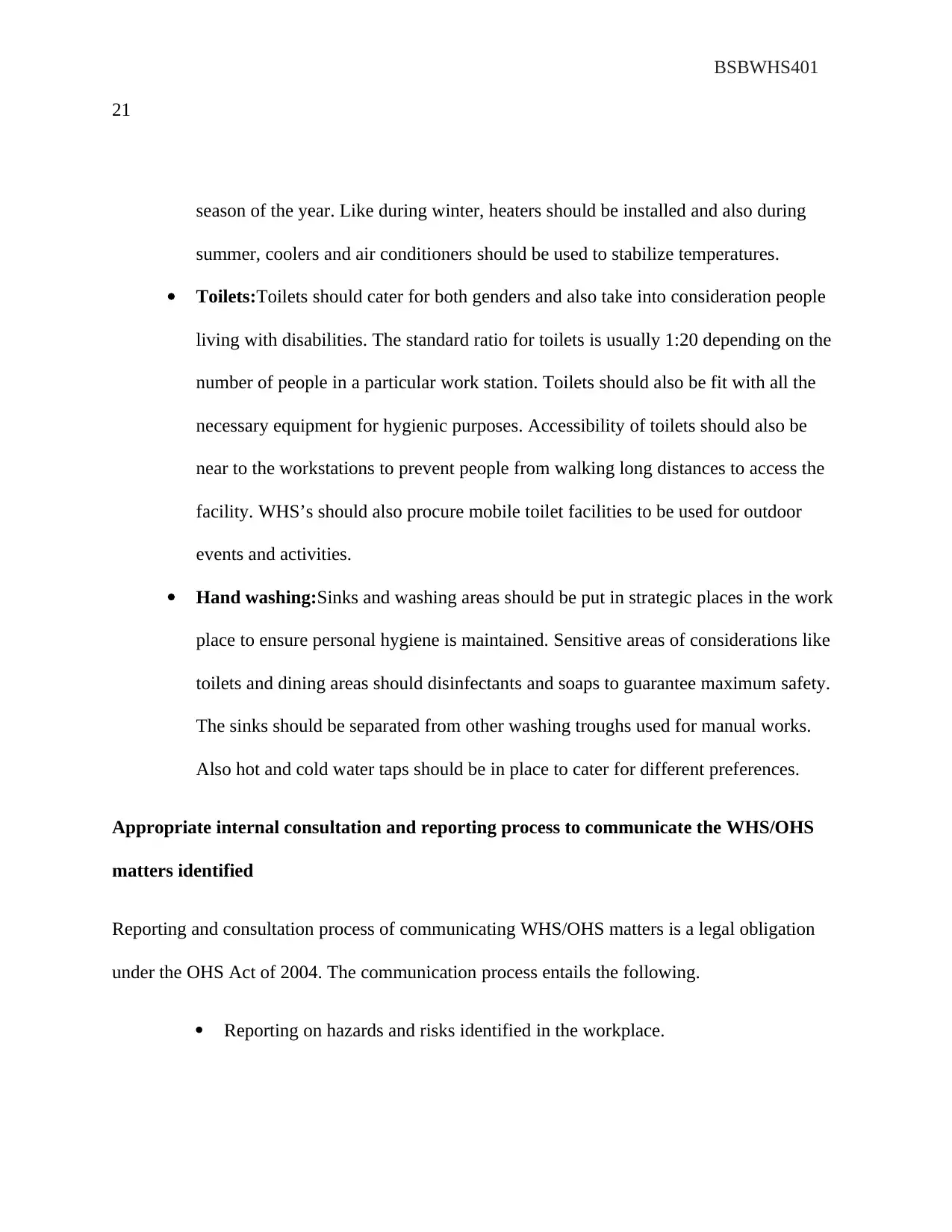
BSBWHS401
21
season of the year. Like during winter, heaters should be installed and also during
summer, coolers and air conditioners should be used to stabilize temperatures.
Toilets:Toilets should cater for both genders and also take into consideration people
living with disabilities. The standard ratio for toilets is usually 1:20 depending on the
number of people in a particular work station. Toilets should also be fit with all the
necessary equipment for hygienic purposes. Accessibility of toilets should also be
near to the workstations to prevent people from walking long distances to access the
facility. WHS’s should also procure mobile toilet facilities to be used for outdoor
events and activities.
Hand washing:Sinks and washing areas should be put in strategic places in the work
place to ensure personal hygiene is maintained. Sensitive areas of considerations like
toilets and dining areas should disinfectants and soaps to guarantee maximum safety.
The sinks should be separated from other washing troughs used for manual works.
Also hot and cold water taps should be in place to cater for different preferences.
Appropriate internal consultation and reporting process to communicate the WHS/OHS
matters identified
Reporting and consultation process of communicating WHS/OHS matters is a legal obligation
under the OHS Act of 2004. The communication process entails the following.
Reporting on hazards and risks identified in the workplace.
21
season of the year. Like during winter, heaters should be installed and also during
summer, coolers and air conditioners should be used to stabilize temperatures.
Toilets:Toilets should cater for both genders and also take into consideration people
living with disabilities. The standard ratio for toilets is usually 1:20 depending on the
number of people in a particular work station. Toilets should also be fit with all the
necessary equipment for hygienic purposes. Accessibility of toilets should also be
near to the workstations to prevent people from walking long distances to access the
facility. WHS’s should also procure mobile toilet facilities to be used for outdoor
events and activities.
Hand washing:Sinks and washing areas should be put in strategic places in the work
place to ensure personal hygiene is maintained. Sensitive areas of considerations like
toilets and dining areas should disinfectants and soaps to guarantee maximum safety.
The sinks should be separated from other washing troughs used for manual works.
Also hot and cold water taps should be in place to cater for different preferences.
Appropriate internal consultation and reporting process to communicate the WHS/OHS
matters identified
Reporting and consultation process of communicating WHS/OHS matters is a legal obligation
under the OHS Act of 2004. The communication process entails the following.
Reporting on hazards and risks identified in the workplace.

BSBWHS401
22
Resolutions reached on the roadmap to deal with hazards and risk in the
workplace.
Recommendations for the best ways to monitor and implement risk mitigation
measures in the workplace.
Review of job descriptions and redeployment of staff to areas that need more
WHS attention.
The communication should also ensure that all legal requirements have been meet
and appropriately reported in the communication.
Communication requirements
It’s the duty of the supervisors or line managers to ensure the communications are in line with
the following.
Report on the findings of the WHS audit
According to the audit report on recommendations and changes that have to be
put in place.
Give a detailed report on the findings of the WHS work place inspection.
Provide an outline of all the risks identified in the inspection.
Implementation of communicated information
The university being big with different faculties and departments, the best way to implement
communicated is through clustering. This can be small groups of individuals sharing common
classes or workstations. This according to the 2004 Act is called Designated Work Group. The
22
Resolutions reached on the roadmap to deal with hazards and risk in the
workplace.
Recommendations for the best ways to monitor and implement risk mitigation
measures in the workplace.
Review of job descriptions and redeployment of staff to areas that need more
WHS attention.
The communication should also ensure that all legal requirements have been meet
and appropriately reported in the communication.
Communication requirements
It’s the duty of the supervisors or line managers to ensure the communications are in line with
the following.
Report on the findings of the WHS audit
According to the audit report on recommendations and changes that have to be
put in place.
Give a detailed report on the findings of the WHS work place inspection.
Provide an outline of all the risks identified in the inspection.
Implementation of communicated information
The university being big with different faculties and departments, the best way to implement
communicated is through clustering. This can be small groups of individuals sharing common
classes or workstations. This according to the 2004 Act is called Designated Work Group. The
Secure Best Marks with AI Grader
Need help grading? Try our AI Grader for instant feedback on your assignments.

BSBWHS401
23
DWG groups are determined by the number of employees in the work place. The number of
employees who perform similar tasks and the nature of hazards involved in the particular duty to
be carried out.
How to determine effective communication channels
WHS Committees: This a structured team with a supervisor. Communicating through
the committee ensures the information is received and implemented.
Email Updates: This is very effective as it ensures information is circulated to all the
group members.
Newsletter: Digital or hard copy newsletter can be distributed to staff and students.
Intranet: Information can be uploaded on the university website. This information can
only be accessed to the university fraternity.
Suggested training needs of the staff, if required, to meet OHS requirements
According WHS 2011 Act is mandatory for organizations to conduct continuous training and
awareness to students, workers and staff in the university. The training contains the following
OHS objectives.
Generic OHS Training
Risk specific Training
Task specific OHS Training
23
DWG groups are determined by the number of employees in the work place. The number of
employees who perform similar tasks and the nature of hazards involved in the particular duty to
be carried out.
How to determine effective communication channels
WHS Committees: This a structured team with a supervisor. Communicating through
the committee ensures the information is received and implemented.
Email Updates: This is very effective as it ensures information is circulated to all the
group members.
Newsletter: Digital or hard copy newsletter can be distributed to staff and students.
Intranet: Information can be uploaded on the university website. This information can
only be accessed to the university fraternity.
Suggested training needs of the staff, if required, to meet OHS requirements
According WHS 2011 Act is mandatory for organizations to conduct continuous training and
awareness to students, workers and staff in the university. The training contains the following
OHS objectives.
Generic OHS Training
Risk specific Training
Task specific OHS Training
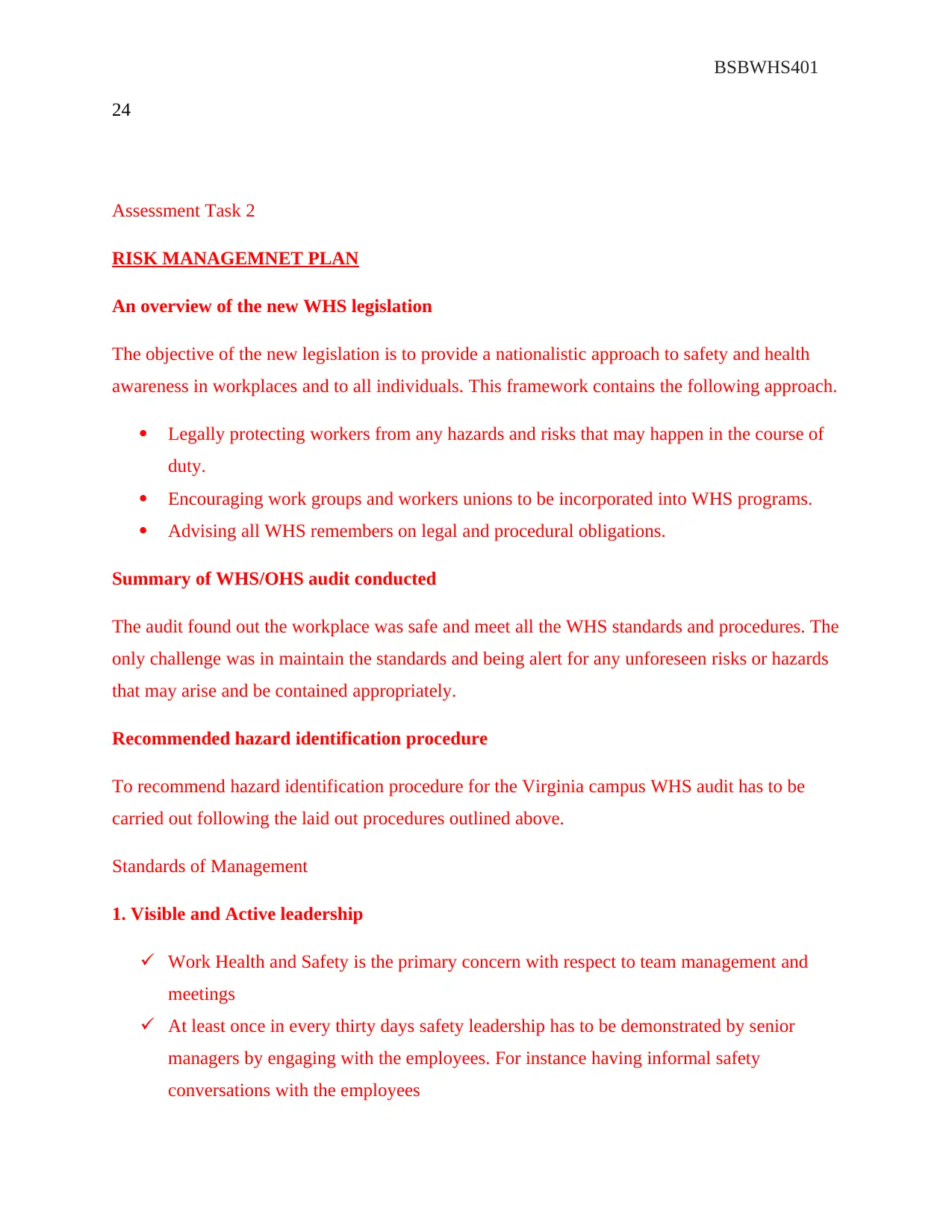
BSBWHS401
24
Assessment Task 2
RISK MANAGEMNET PLAN
An overview of the new WHS legislation
The objective of the new legislation is to provide a nationalistic approach to safety and health
awareness in workplaces and to all individuals. This framework contains the following approach.
Legally protecting workers from any hazards and risks that may happen in the course of
duty.
Encouraging work groups and workers unions to be incorporated into WHS programs.
Advising all WHS remembers on legal and procedural obligations.
Summary of WHS/OHS audit conducted
The audit found out the workplace was safe and meet all the WHS standards and procedures. The
only challenge was in maintain the standards and being alert for any unforeseen risks or hazards
that may arise and be contained appropriately.
Recommended hazard identification procedure
To recommend hazard identification procedure for the Virginia campus WHS audit has to be
carried out following the laid out procedures outlined above.
Standards of Management
1. Visible and Active leadership
Work Health and Safety is the primary concern with respect to team management and
meetings
At least once in every thirty days safety leadership has to be demonstrated by senior
managers by engaging with the employees. For instance having informal safety
conversations with the employees
24
Assessment Task 2
RISK MANAGEMNET PLAN
An overview of the new WHS legislation
The objective of the new legislation is to provide a nationalistic approach to safety and health
awareness in workplaces and to all individuals. This framework contains the following approach.
Legally protecting workers from any hazards and risks that may happen in the course of
duty.
Encouraging work groups and workers unions to be incorporated into WHS programs.
Advising all WHS remembers on legal and procedural obligations.
Summary of WHS/OHS audit conducted
The audit found out the workplace was safe and meet all the WHS standards and procedures. The
only challenge was in maintain the standards and being alert for any unforeseen risks or hazards
that may arise and be contained appropriately.
Recommended hazard identification procedure
To recommend hazard identification procedure for the Virginia campus WHS audit has to be
carried out following the laid out procedures outlined above.
Standards of Management
1. Visible and Active leadership
Work Health and Safety is the primary concern with respect to team management and
meetings
At least once in every thirty days safety leadership has to be demonstrated by senior
managers by engaging with the employees. For instance having informal safety
conversations with the employees
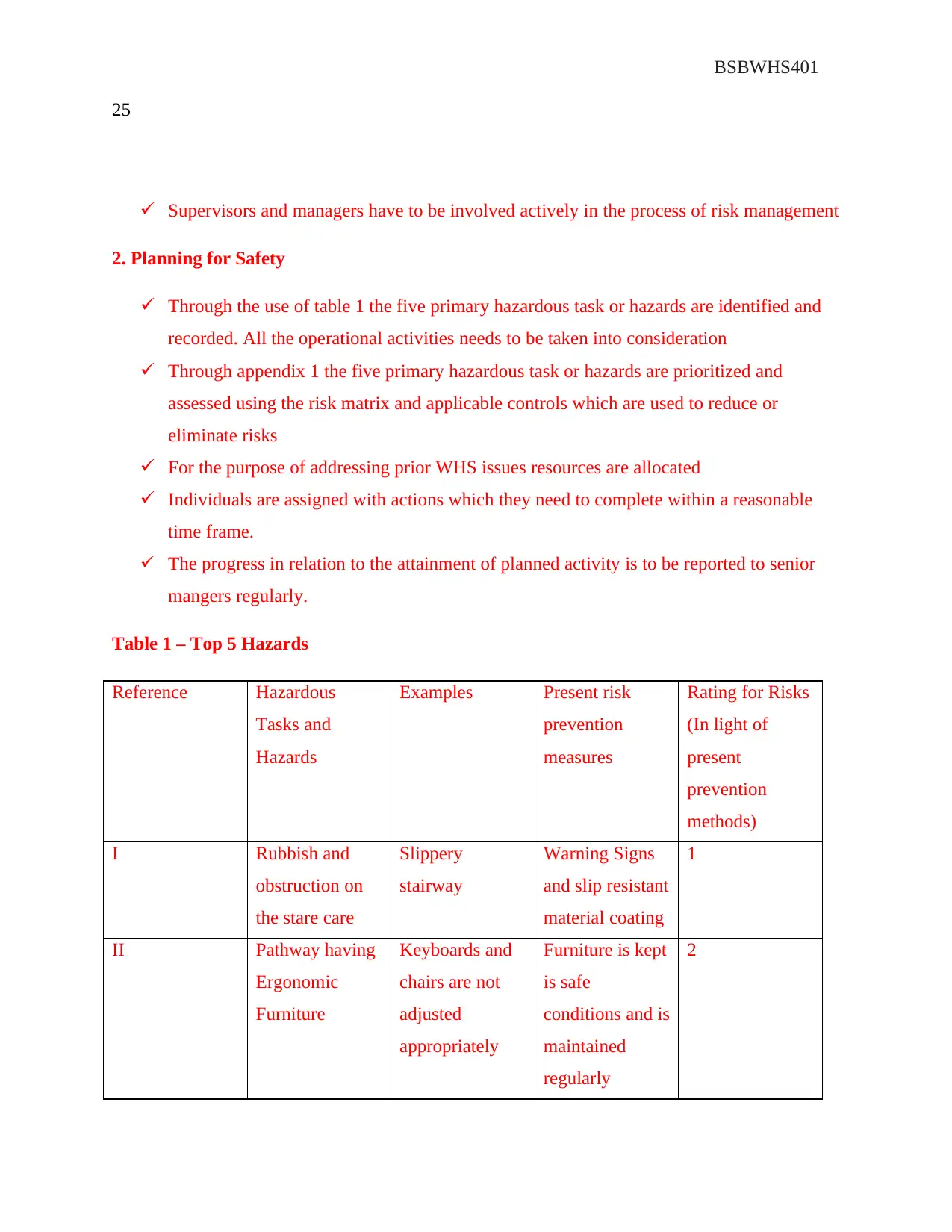
BSBWHS401
25
Supervisors and managers have to be involved actively in the process of risk management
2. Planning for Safety
Through the use of table 1 the five primary hazardous task or hazards are identified and
recorded. All the operational activities needs to be taken into consideration
Through appendix 1 the five primary hazardous task or hazards are prioritized and
assessed using the risk matrix and applicable controls which are used to reduce or
eliminate risks
For the purpose of addressing prior WHS issues resources are allocated
Individuals are assigned with actions which they need to complete within a reasonable
time frame.
The progress in relation to the attainment of planned activity is to be reported to senior
mangers regularly.
Table 1 – Top 5 Hazards
Reference Hazardous
Tasks and
Hazards
Examples Present risk
prevention
measures
Rating for Risks
(In light of
present
prevention
methods)
I Rubbish and
obstruction on
the stare care
Slippery
stairway
Warning Signs
and slip resistant
material coating
1
II Pathway having
Ergonomic
Furniture
Keyboards and
chairs are not
adjusted
appropriately
Furniture is kept
is safe
conditions and is
maintained
regularly
2
25
Supervisors and managers have to be involved actively in the process of risk management
2. Planning for Safety
Through the use of table 1 the five primary hazardous task or hazards are identified and
recorded. All the operational activities needs to be taken into consideration
Through appendix 1 the five primary hazardous task or hazards are prioritized and
assessed using the risk matrix and applicable controls which are used to reduce or
eliminate risks
For the purpose of addressing prior WHS issues resources are allocated
Individuals are assigned with actions which they need to complete within a reasonable
time frame.
The progress in relation to the attainment of planned activity is to be reported to senior
mangers regularly.
Table 1 – Top 5 Hazards
Reference Hazardous
Tasks and
Hazards
Examples Present risk
prevention
measures
Rating for Risks
(In light of
present
prevention
methods)
I Rubbish and
obstruction on
the stare care
Slippery
stairway
Warning Signs
and slip resistant
material coating
1
II Pathway having
Ergonomic
Furniture
Keyboards and
chairs are not
adjusted
appropriately
Furniture is kept
is safe
conditions and is
maintained
regularly
2
Paraphrase This Document
Need a fresh take? Get an instant paraphrase of this document with our AI Paraphraser
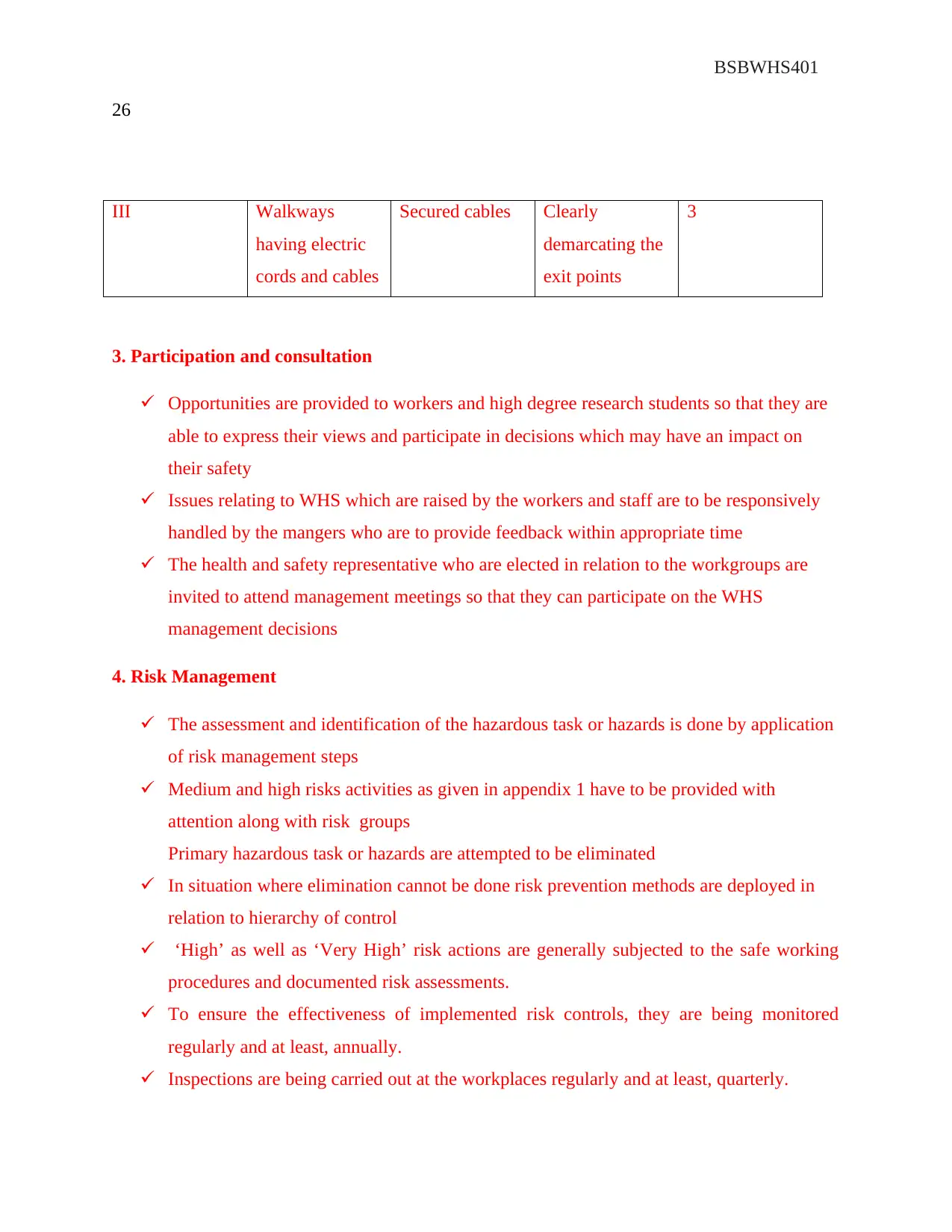
BSBWHS401
26
III Walkways
having electric
cords and cables
Secured cables Clearly
demarcating the
exit points
3
3. Participation and consultation
Opportunities are provided to workers and high degree research students so that they are
able to express their views and participate in decisions which may have an impact on
their safety
Issues relating to WHS which are raised by the workers and staff are to be responsively
handled by the mangers who are to provide feedback within appropriate time
The health and safety representative who are elected in relation to the workgroups are
invited to attend management meetings so that they can participate on the WHS
management decisions
4. Risk Management
The assessment and identification of the hazardous task or hazards is done by application
of risk management steps
Medium and high risks activities as given in appendix 1 have to be provided with
attention along with risk groups
Primary hazardous task or hazards are attempted to be eliminated
In situation where elimination cannot be done risk prevention methods are deployed in
relation to hierarchy of control
‘High’ as well as ‘Very High’ risk actions are generally subjected to the safe working
procedures and documented risk assessments.
To ensure the effectiveness of implemented risk controls, they are being monitored
regularly and at least, annually.
Inspections are being carried out at the workplaces regularly and at least, quarterly.
26
III Walkways
having electric
cords and cables
Secured cables Clearly
demarcating the
exit points
3
3. Participation and consultation
Opportunities are provided to workers and high degree research students so that they are
able to express their views and participate in decisions which may have an impact on
their safety
Issues relating to WHS which are raised by the workers and staff are to be responsively
handled by the mangers who are to provide feedback within appropriate time
The health and safety representative who are elected in relation to the workgroups are
invited to attend management meetings so that they can participate on the WHS
management decisions
4. Risk Management
The assessment and identification of the hazardous task or hazards is done by application
of risk management steps
Medium and high risks activities as given in appendix 1 have to be provided with
attention along with risk groups
Primary hazardous task or hazards are attempted to be eliminated
In situation where elimination cannot be done risk prevention methods are deployed in
relation to hierarchy of control
‘High’ as well as ‘Very High’ risk actions are generally subjected to the safe working
procedures and documented risk assessments.
To ensure the effectiveness of implemented risk controls, they are being monitored
regularly and at least, annually.
Inspections are being carried out at the workplaces regularly and at least, quarterly.
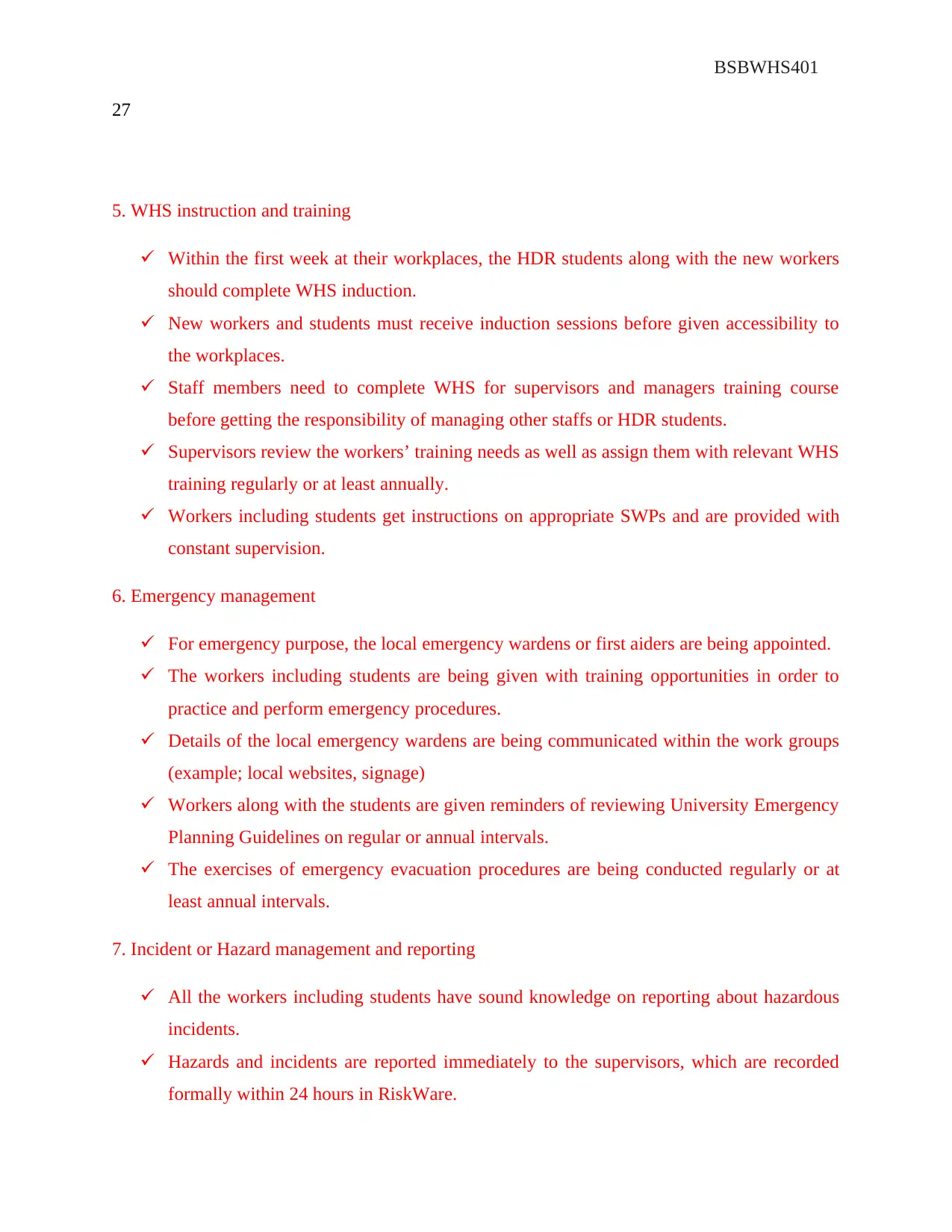
BSBWHS401
27
5. WHS instruction and training
Within the first week at their workplaces, the HDR students along with the new workers
should complete WHS induction.
New workers and students must receive induction sessions before given accessibility to
the workplaces.
Staff members need to complete WHS for supervisors and managers training course
before getting the responsibility of managing other staffs or HDR students.
Supervisors review the workers’ training needs as well as assign them with relevant WHS
training regularly or at least annually.
Workers including students get instructions on appropriate SWPs and are provided with
constant supervision.
6. Emergency management
For emergency purpose, the local emergency wardens or first aiders are being appointed.
The workers including students are being given with training opportunities in order to
practice and perform emergency procedures.
Details of the local emergency wardens are being communicated within the work groups
(example; local websites, signage)
Workers along with the students are given reminders of reviewing University Emergency
Planning Guidelines on regular or annual intervals.
The exercises of emergency evacuation procedures are being conducted regularly or at
least annual intervals.
7. Incident or Hazard management and reporting
All the workers including students have sound knowledge on reporting about hazardous
incidents.
Hazards and incidents are reported immediately to the supervisors, which are recorded
formally within 24 hours in RiskWare.
27
5. WHS instruction and training
Within the first week at their workplaces, the HDR students along with the new workers
should complete WHS induction.
New workers and students must receive induction sessions before given accessibility to
the workplaces.
Staff members need to complete WHS for supervisors and managers training course
before getting the responsibility of managing other staffs or HDR students.
Supervisors review the workers’ training needs as well as assign them with relevant WHS
training regularly or at least annually.
Workers including students get instructions on appropriate SWPs and are provided with
constant supervision.
6. Emergency management
For emergency purpose, the local emergency wardens or first aiders are being appointed.
The workers including students are being given with training opportunities in order to
practice and perform emergency procedures.
Details of the local emergency wardens are being communicated within the work groups
(example; local websites, signage)
Workers along with the students are given reminders of reviewing University Emergency
Planning Guidelines on regular or annual intervals.
The exercises of emergency evacuation procedures are being conducted regularly or at
least annual intervals.
7. Incident or Hazard management and reporting
All the workers including students have sound knowledge on reporting about hazardous
incidents.
Hazards and incidents are reported immediately to the supervisors, which are recorded
formally within 24 hours in RiskWare.

BSBWHS401
28
8. Suppliers, purchasing and contractors controls
The hazards which are related to the materials or equipments are being taken under
consideration.
Several attempts are being made while purchasing the safest services and products.
The mandatory selection criterion is safety especially during tender and quote evaluation
procedures.
The specifications of service contract typically involve safety performance indicators and
performance requirements.
The service contractors are being qualified and that too, in an appropriate manner.
28
8. Suppliers, purchasing and contractors controls
The hazards which are related to the materials or equipments are being taken under
consideration.
Several attempts are being made while purchasing the safest services and products.
The mandatory selection criterion is safety especially during tender and quote evaluation
procedures.
The specifications of service contract typically involve safety performance indicators and
performance requirements.
The service contractors are being qualified and that too, in an appropriate manner.
Secure Best Marks with AI Grader
Need help grading? Try our AI Grader for instant feedback on your assignments.
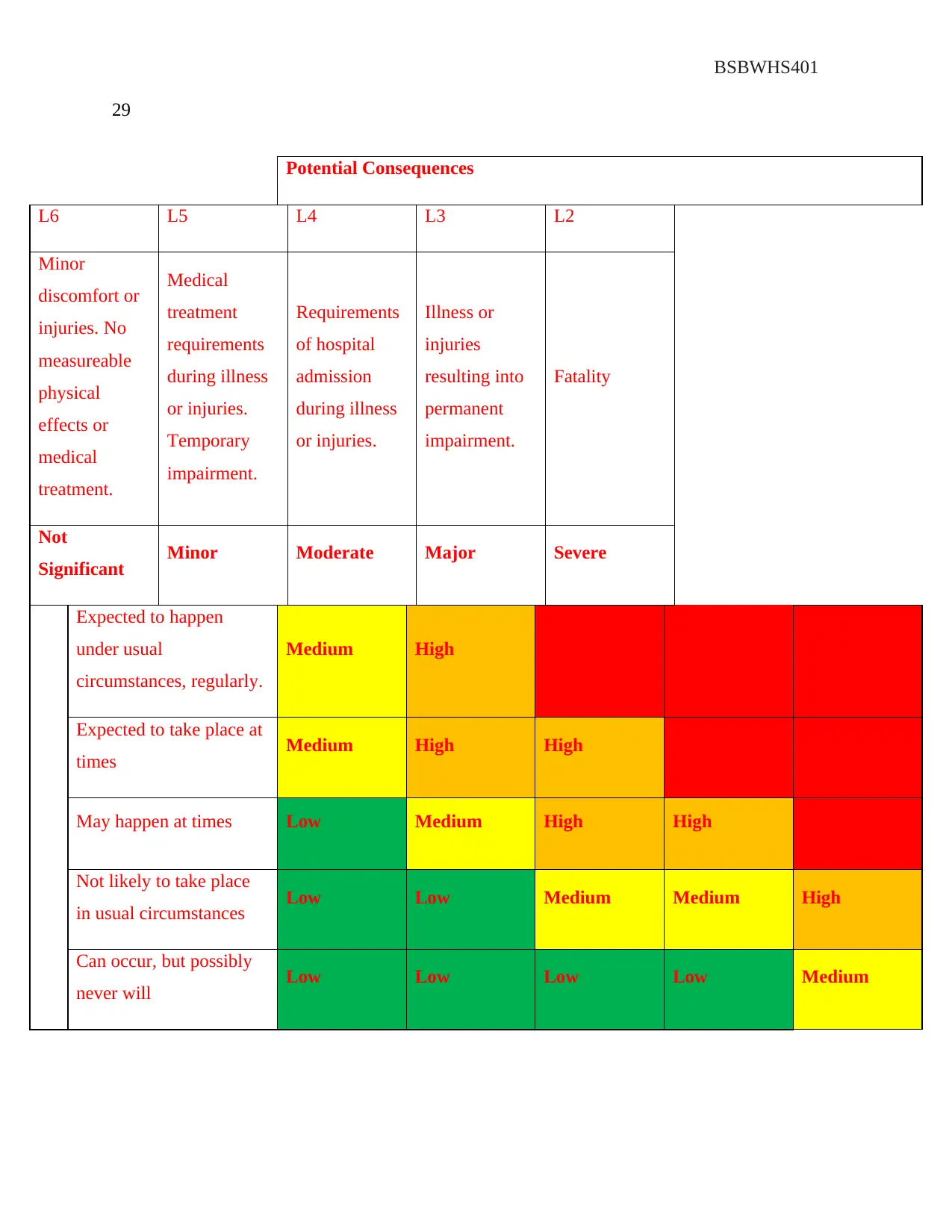
BSBWHS401
29
Potential Consequences
L6 L5 L4 L3 L2
Minor
discomfort or
injuries. No
measureable
physical
effects or
medical
treatment.
Medical
treatment
requirements
during illness
or injuries.
Temporary
impairment.
Requirements
of hospital
admission
during illness
or injuries.
Illness or
injuries
resulting into
permanent
impairment.
Fatality
Not
Significant Minor Moderate Major Severe
Expected to happen
under usual
circumstances, regularly.
Medium High Very High Very High Very High
Expected to take place at
times Medium High High Very High Very High
May happen at times Low Medium High High Very High
Not likely to take place
in usual circumstances Low Low Medium Medium High
Can occur, but possibly
never will Low Low Low Low Medium
29
Potential Consequences
L6 L5 L4 L3 L2
Minor
discomfort or
injuries. No
measureable
physical
effects or
medical
treatment.
Medical
treatment
requirements
during illness
or injuries.
Temporary
impairment.
Requirements
of hospital
admission
during illness
or injuries.
Illness or
injuries
resulting into
permanent
impairment.
Fatality
Not
Significant Minor Moderate Major Severe
Expected to happen
under usual
circumstances, regularly.
Medium High Very High Very High Very High
Expected to take place at
times Medium High High Very High Very High
May happen at times Low Medium High High Very High
Not likely to take place
in usual circumstances Low Low Medium Medium High
Can occur, but possibly
never will Low Low Low Low Medium

BSBWHS401
30
30
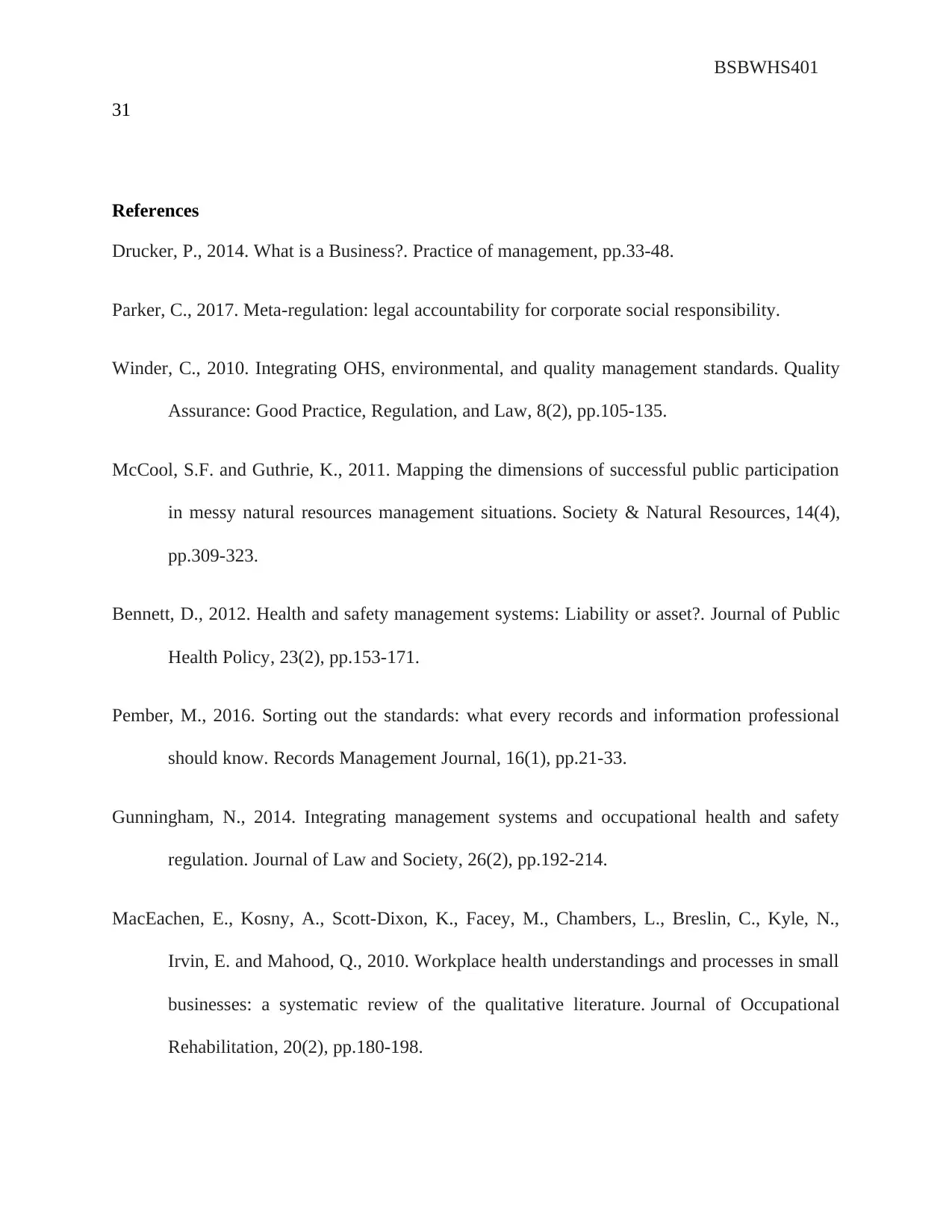
BSBWHS401
31
References
Drucker, P., 2014. What is a Business?. Practice of management, pp.33-48.
Parker, C., 2017. Meta-regulation: legal accountability for corporate social responsibility.
Winder, C., 2010. Integrating OHS, environmental, and quality management standards. Quality
Assurance: Good Practice, Regulation, and Law, 8(2), pp.105-135.
McCool, S.F. and Guthrie, K., 2011. Mapping the dimensions of successful public participation
in messy natural resources management situations. Society & Natural Resources, 14(4),
pp.309-323.
Bennett, D., 2012. Health and safety management systems: Liability or asset?. Journal of Public
Health Policy, 23(2), pp.153-171.
Pember, M., 2016. Sorting out the standards: what every records and information professional
should know. Records Management Journal, 16(1), pp.21-33.
Gunningham, N., 2014. Integrating management systems and occupational health and safety
regulation. Journal of Law and Society, 26(2), pp.192-214.
MacEachen, E., Kosny, A., Scott-Dixon, K., Facey, M., Chambers, L., Breslin, C., Kyle, N.,
Irvin, E. and Mahood, Q., 2010. Workplace health understandings and processes in small
businesses: a systematic review of the qualitative literature. Journal of Occupational
Rehabilitation, 20(2), pp.180-198.
31
References
Drucker, P., 2014. What is a Business?. Practice of management, pp.33-48.
Parker, C., 2017. Meta-regulation: legal accountability for corporate social responsibility.
Winder, C., 2010. Integrating OHS, environmental, and quality management standards. Quality
Assurance: Good Practice, Regulation, and Law, 8(2), pp.105-135.
McCool, S.F. and Guthrie, K., 2011. Mapping the dimensions of successful public participation
in messy natural resources management situations. Society & Natural Resources, 14(4),
pp.309-323.
Bennett, D., 2012. Health and safety management systems: Liability or asset?. Journal of Public
Health Policy, 23(2), pp.153-171.
Pember, M., 2016. Sorting out the standards: what every records and information professional
should know. Records Management Journal, 16(1), pp.21-33.
Gunningham, N., 2014. Integrating management systems and occupational health and safety
regulation. Journal of Law and Society, 26(2), pp.192-214.
MacEachen, E., Kosny, A., Scott-Dixon, K., Facey, M., Chambers, L., Breslin, C., Kyle, N.,
Irvin, E. and Mahood, Q., 2010. Workplace health understandings and processes in small
businesses: a systematic review of the qualitative literature. Journal of Occupational
Rehabilitation, 20(2), pp.180-198.
Paraphrase This Document
Need a fresh take? Get an instant paraphrase of this document with our AI Paraphraser
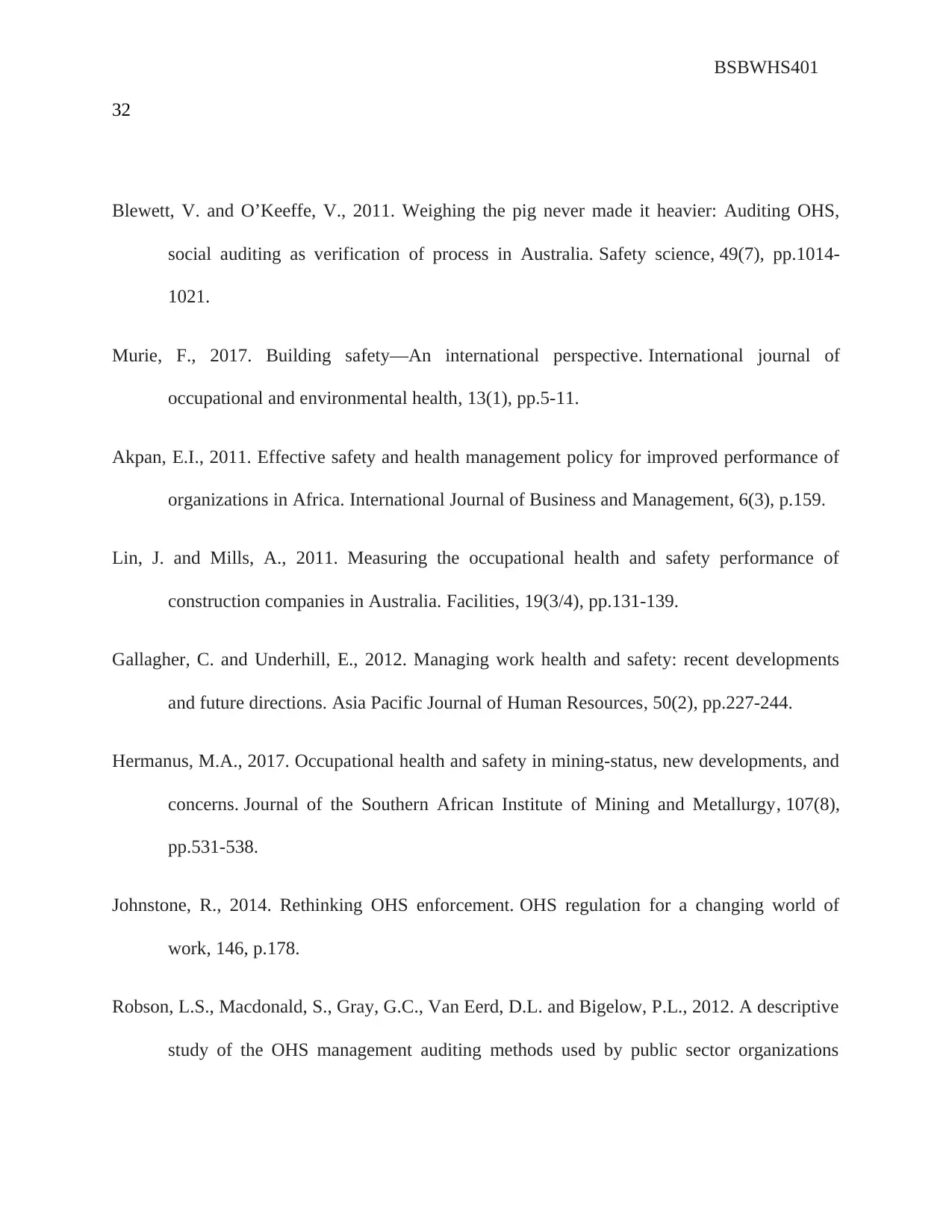
BSBWHS401
32
Blewett, V. and O’Keeffe, V., 2011. Weighing the pig never made it heavier: Auditing OHS,
social auditing as verification of process in Australia. Safety science, 49(7), pp.1014-
1021.
Murie, F., 2017. Building safety—An international perspective. International journal of
occupational and environmental health, 13(1), pp.5-11.
Akpan, E.I., 2011. Effective safety and health management policy for improved performance of
organizations in Africa. International Journal of Business and Management, 6(3), p.159.
Lin, J. and Mills, A., 2011. Measuring the occupational health and safety performance of
construction companies in Australia. Facilities, 19(3/4), pp.131-139.
Gallagher, C. and Underhill, E., 2012. Managing work health and safety: recent developments
and future directions. Asia Pacific Journal of Human Resources, 50(2), pp.227-244.
Hermanus, M.A., 2017. Occupational health and safety in mining-status, new developments, and
concerns. Journal of the Southern African Institute of Mining and Metallurgy, 107(8),
pp.531-538.
Johnstone, R., 2014. Rethinking OHS enforcement. OHS regulation for a changing world of
work, 146, p.178.
Robson, L.S., Macdonald, S., Gray, G.C., Van Eerd, D.L. and Bigelow, P.L., 2012. A descriptive
study of the OHS management auditing methods used by public sector organizations
32
Blewett, V. and O’Keeffe, V., 2011. Weighing the pig never made it heavier: Auditing OHS,
social auditing as verification of process in Australia. Safety science, 49(7), pp.1014-
1021.
Murie, F., 2017. Building safety—An international perspective. International journal of
occupational and environmental health, 13(1), pp.5-11.
Akpan, E.I., 2011. Effective safety and health management policy for improved performance of
organizations in Africa. International Journal of Business and Management, 6(3), p.159.
Lin, J. and Mills, A., 2011. Measuring the occupational health and safety performance of
construction companies in Australia. Facilities, 19(3/4), pp.131-139.
Gallagher, C. and Underhill, E., 2012. Managing work health and safety: recent developments
and future directions. Asia Pacific Journal of Human Resources, 50(2), pp.227-244.
Hermanus, M.A., 2017. Occupational health and safety in mining-status, new developments, and
concerns. Journal of the Southern African Institute of Mining and Metallurgy, 107(8),
pp.531-538.
Johnstone, R., 2014. Rethinking OHS enforcement. OHS regulation for a changing world of
work, 146, p.178.
Robson, L.S., Macdonald, S., Gray, G.C., Van Eerd, D.L. and Bigelow, P.L., 2012. A descriptive
study of the OHS management auditing methods used by public sector organizations

BSBWHS401
33
conducting audits of workplaces: Implications for audit reliability and validity. Safety
science, 50(2), pp.181-189.
Woon, P., 2010. A Computer Procedure for Generating Visible-Line Drawings of Solids
Bounded by Quadric Surfaces(No. TR-403-15).NEW YORK UNIV BRONX DEPT OF
ELECTRICAL ENGINEERING.
Bueding, E. and Orrell, S.A., 2014. A mild procedure for the isolation of polydisperse glycogen
from animal tissues.JOHNS HOPKINS UNIV BALTIMORE MD SCHOOL OF
HYGIENE AND PUBLIC HEALTH.
Horning, J.J., 2011. A study of grammatical inference (No.CS-139). STANFORD UNIV CALIF
DEPT OF COMPUTER SCIENCE.
Wilson, E.L., 2018. A computer program for the dynamic stress analysis of underground
structures (No. SEL-68-1). CALIFORNIA UNIV BERKELEY STRUCTURAL
ENGINEERING LAB.
Pellini, W.S., 2018. ADVANCES IN FRACTURE TOUGHNESS CHARACTERIZATION
PROCEDURES AND IN QUANTITATIVE INTERPRETATIONS TO FRACTURE-
SAFE DESIGN FOR STRUCTURAL STEELS (No.NRL-6713).NAVAL RESEARCH
LAB WASHINGTON DC.
33
conducting audits of workplaces: Implications for audit reliability and validity. Safety
science, 50(2), pp.181-189.
Woon, P., 2010. A Computer Procedure for Generating Visible-Line Drawings of Solids
Bounded by Quadric Surfaces(No. TR-403-15).NEW YORK UNIV BRONX DEPT OF
ELECTRICAL ENGINEERING.
Bueding, E. and Orrell, S.A., 2014. A mild procedure for the isolation of polydisperse glycogen
from animal tissues.JOHNS HOPKINS UNIV BALTIMORE MD SCHOOL OF
HYGIENE AND PUBLIC HEALTH.
Horning, J.J., 2011. A study of grammatical inference (No.CS-139). STANFORD UNIV CALIF
DEPT OF COMPUTER SCIENCE.
Wilson, E.L., 2018. A computer program for the dynamic stress analysis of underground
structures (No. SEL-68-1). CALIFORNIA UNIV BERKELEY STRUCTURAL
ENGINEERING LAB.
Pellini, W.S., 2018. ADVANCES IN FRACTURE TOUGHNESS CHARACTERIZATION
PROCEDURES AND IN QUANTITATIVE INTERPRETATIONS TO FRACTURE-
SAFE DESIGN FOR STRUCTURAL STEELS (No.NRL-6713).NAVAL RESEARCH
LAB WASHINGTON DC.
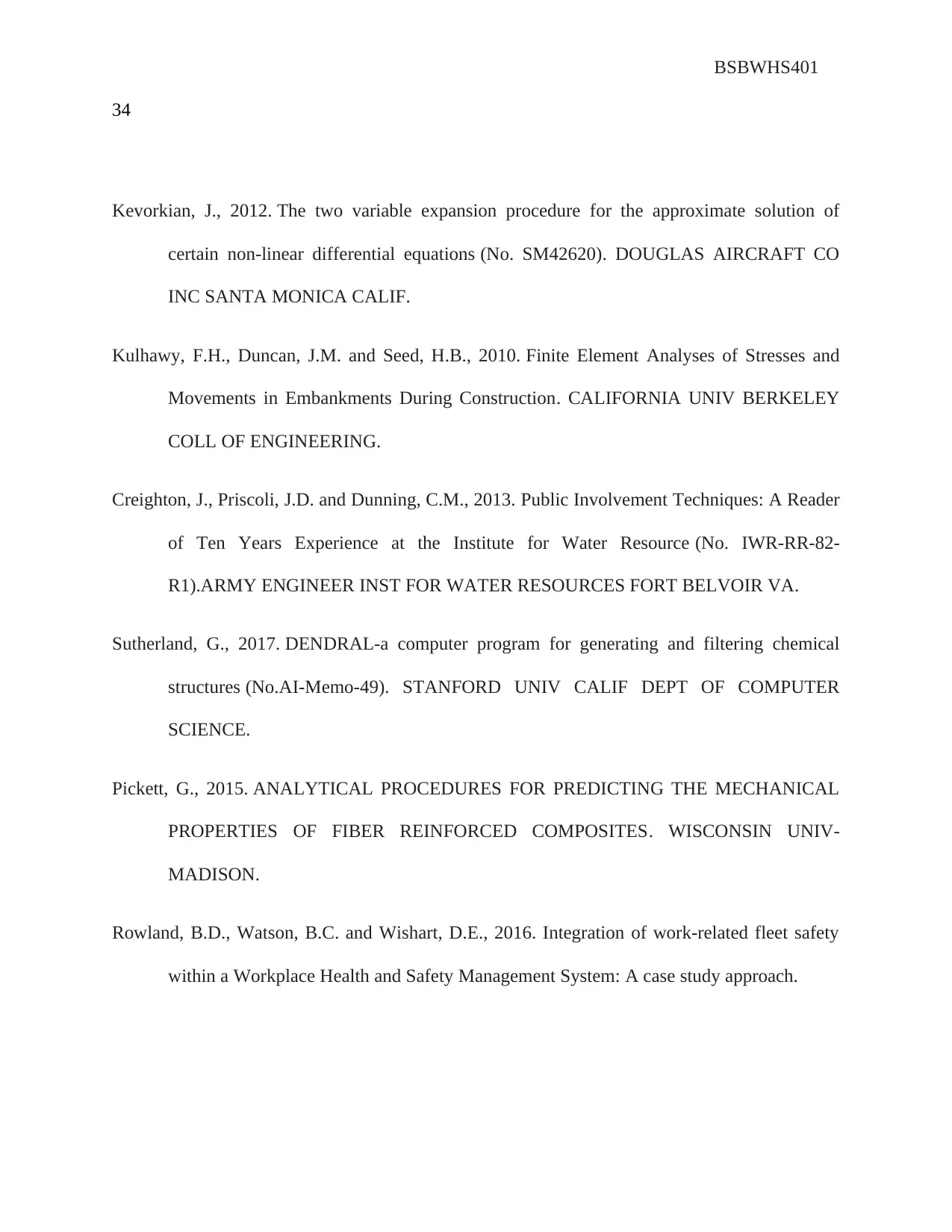
BSBWHS401
34
Kevorkian, J., 2012. The two variable expansion procedure for the approximate solution of
certain non-linear differential equations (No. SM42620). DOUGLAS AIRCRAFT CO
INC SANTA MONICA CALIF.
Kulhawy, F.H., Duncan, J.M. and Seed, H.B., 2010. Finite Element Analyses of Stresses and
Movements in Embankments During Construction. CALIFORNIA UNIV BERKELEY
COLL OF ENGINEERING.
Creighton, J., Priscoli, J.D. and Dunning, C.M., 2013. Public Involvement Techniques: A Reader
of Ten Years Experience at the Institute for Water Resource (No. IWR-RR-82-
R1).ARMY ENGINEER INST FOR WATER RESOURCES FORT BELVOIR VA.
Sutherland, G., 2017. DENDRAL-a computer program for generating and filtering chemical
structures (No.AI-Memo-49). STANFORD UNIV CALIF DEPT OF COMPUTER
SCIENCE.
Pickett, G., 2015. ANALYTICAL PROCEDURES FOR PREDICTING THE MECHANICAL
PROPERTIES OF FIBER REINFORCED COMPOSITES. WISCONSIN UNIV-
MADISON.
Rowland, B.D., Watson, B.C. and Wishart, D.E., 2016. Integration of work-related fleet safety
within a Workplace Health and Safety Management System: A case study approach.
34
Kevorkian, J., 2012. The two variable expansion procedure for the approximate solution of
certain non-linear differential equations (No. SM42620). DOUGLAS AIRCRAFT CO
INC SANTA MONICA CALIF.
Kulhawy, F.H., Duncan, J.M. and Seed, H.B., 2010. Finite Element Analyses of Stresses and
Movements in Embankments During Construction. CALIFORNIA UNIV BERKELEY
COLL OF ENGINEERING.
Creighton, J., Priscoli, J.D. and Dunning, C.M., 2013. Public Involvement Techniques: A Reader
of Ten Years Experience at the Institute for Water Resource (No. IWR-RR-82-
R1).ARMY ENGINEER INST FOR WATER RESOURCES FORT BELVOIR VA.
Sutherland, G., 2017. DENDRAL-a computer program for generating and filtering chemical
structures (No.AI-Memo-49). STANFORD UNIV CALIF DEPT OF COMPUTER
SCIENCE.
Pickett, G., 2015. ANALYTICAL PROCEDURES FOR PREDICTING THE MECHANICAL
PROPERTIES OF FIBER REINFORCED COMPOSITES. WISCONSIN UNIV-
MADISON.
Rowland, B.D., Watson, B.C. and Wishart, D.E., 2016. Integration of work-related fleet safety
within a Workplace Health and Safety Management System: A case study approach.
Secure Best Marks with AI Grader
Need help grading? Try our AI Grader for instant feedback on your assignments.
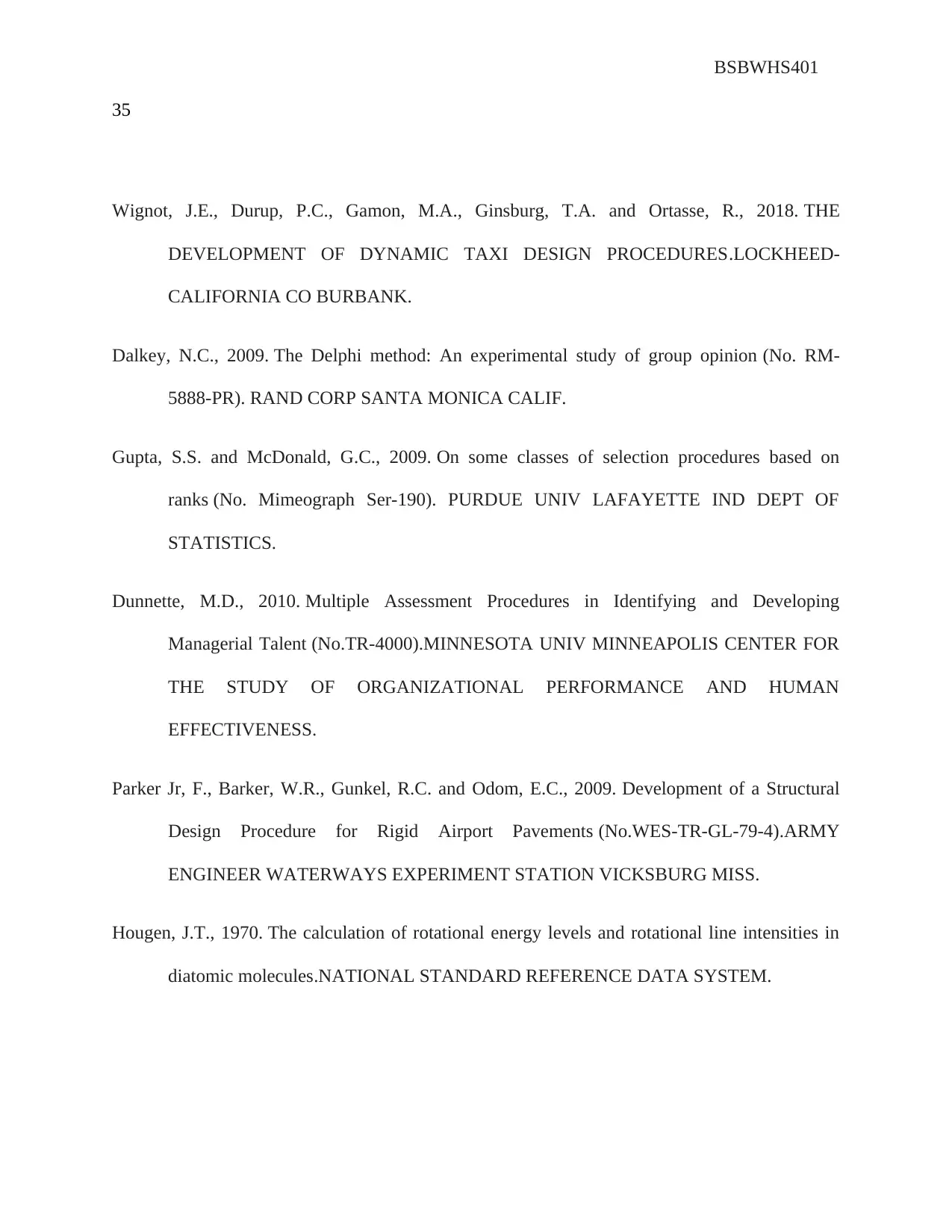
BSBWHS401
35
Wignot, J.E., Durup, P.C., Gamon, M.A., Ginsburg, T.A. and Ortasse, R., 2018. THE
DEVELOPMENT OF DYNAMIC TAXI DESIGN PROCEDURES.LOCKHEED-
CALIFORNIA CO BURBANK.
Dalkey, N.C., 2009. The Delphi method: An experimental study of group opinion (No. RM-
5888-PR). RAND CORP SANTA MONICA CALIF.
Gupta, S.S. and McDonald, G.C., 2009. On some classes of selection procedures based on
ranks (No. Mimeograph Ser-190). PURDUE UNIV LAFAYETTE IND DEPT OF
STATISTICS.
Dunnette, M.D., 2010. Multiple Assessment Procedures in Identifying and Developing
Managerial Talent (No.TR-4000).MINNESOTA UNIV MINNEAPOLIS CENTER FOR
THE STUDY OF ORGANIZATIONAL PERFORMANCE AND HUMAN
EFFECTIVENESS.
Parker Jr, F., Barker, W.R., Gunkel, R.C. and Odom, E.C., 2009. Development of a Structural
Design Procedure for Rigid Airport Pavements (No.WES-TR-GL-79-4).ARMY
ENGINEER WATERWAYS EXPERIMENT STATION VICKSBURG MISS.
Hougen, J.T., 1970. The calculation of rotational energy levels and rotational line intensities in
diatomic molecules.NATIONAL STANDARD REFERENCE DATA SYSTEM.
35
Wignot, J.E., Durup, P.C., Gamon, M.A., Ginsburg, T.A. and Ortasse, R., 2018. THE
DEVELOPMENT OF DYNAMIC TAXI DESIGN PROCEDURES.LOCKHEED-
CALIFORNIA CO BURBANK.
Dalkey, N.C., 2009. The Delphi method: An experimental study of group opinion (No. RM-
5888-PR). RAND CORP SANTA MONICA CALIF.
Gupta, S.S. and McDonald, G.C., 2009. On some classes of selection procedures based on
ranks (No. Mimeograph Ser-190). PURDUE UNIV LAFAYETTE IND DEPT OF
STATISTICS.
Dunnette, M.D., 2010. Multiple Assessment Procedures in Identifying and Developing
Managerial Talent (No.TR-4000).MINNESOTA UNIV MINNEAPOLIS CENTER FOR
THE STUDY OF ORGANIZATIONAL PERFORMANCE AND HUMAN
EFFECTIVENESS.
Parker Jr, F., Barker, W.R., Gunkel, R.C. and Odom, E.C., 2009. Development of a Structural
Design Procedure for Rigid Airport Pavements (No.WES-TR-GL-79-4).ARMY
ENGINEER WATERWAYS EXPERIMENT STATION VICKSBURG MISS.
Hougen, J.T., 1970. The calculation of rotational energy levels and rotational line intensities in
diatomic molecules.NATIONAL STANDARD REFERENCE DATA SYSTEM.
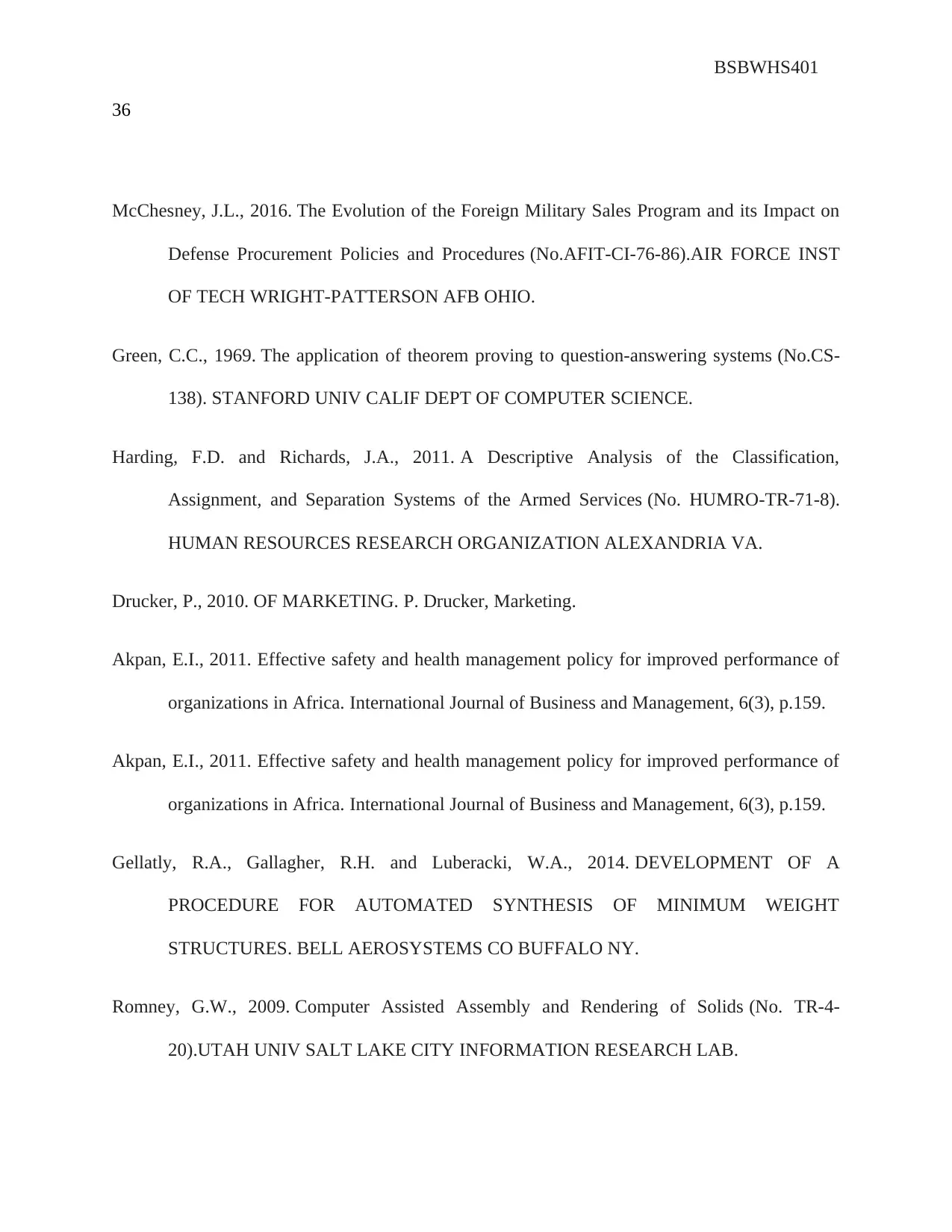
BSBWHS401
36
McChesney, J.L., 2016. The Evolution of the Foreign Military Sales Program and its Impact on
Defense Procurement Policies and Procedures (No.AFIT-CI-76-86).AIR FORCE INST
OF TECH WRIGHT-PATTERSON AFB OHIO.
Green, C.C., 1969. The application of theorem proving to question-answering systems (No.CS-
138). STANFORD UNIV CALIF DEPT OF COMPUTER SCIENCE.
Harding, F.D. and Richards, J.A., 2011. A Descriptive Analysis of the Classification,
Assignment, and Separation Systems of the Armed Services (No. HUMRO-TR-71-8).
HUMAN RESOURCES RESEARCH ORGANIZATION ALEXANDRIA VA.
Drucker, P., 2010. OF MARKETING. P. Drucker, Marketing.
Akpan, E.I., 2011. Effective safety and health management policy for improved performance of
organizations in Africa. International Journal of Business and Management, 6(3), p.159.
Akpan, E.I., 2011. Effective safety and health management policy for improved performance of
organizations in Africa. International Journal of Business and Management, 6(3), p.159.
Gellatly, R.A., Gallagher, R.H. and Luberacki, W.A., 2014. DEVELOPMENT OF A
PROCEDURE FOR AUTOMATED SYNTHESIS OF MINIMUM WEIGHT
STRUCTURES. BELL AEROSYSTEMS CO BUFFALO NY.
Romney, G.W., 2009. Computer Assisted Assembly and Rendering of Solids (No. TR-4-
20).UTAH UNIV SALT LAKE CITY INFORMATION RESEARCH LAB.
36
McChesney, J.L., 2016. The Evolution of the Foreign Military Sales Program and its Impact on
Defense Procurement Policies and Procedures (No.AFIT-CI-76-86).AIR FORCE INST
OF TECH WRIGHT-PATTERSON AFB OHIO.
Green, C.C., 1969. The application of theorem proving to question-answering systems (No.CS-
138). STANFORD UNIV CALIF DEPT OF COMPUTER SCIENCE.
Harding, F.D. and Richards, J.A., 2011. A Descriptive Analysis of the Classification,
Assignment, and Separation Systems of the Armed Services (No. HUMRO-TR-71-8).
HUMAN RESOURCES RESEARCH ORGANIZATION ALEXANDRIA VA.
Drucker, P., 2010. OF MARKETING. P. Drucker, Marketing.
Akpan, E.I., 2011. Effective safety and health management policy for improved performance of
organizations in Africa. International Journal of Business and Management, 6(3), p.159.
Akpan, E.I., 2011. Effective safety and health management policy for improved performance of
organizations in Africa. International Journal of Business and Management, 6(3), p.159.
Gellatly, R.A., Gallagher, R.H. and Luberacki, W.A., 2014. DEVELOPMENT OF A
PROCEDURE FOR AUTOMATED SYNTHESIS OF MINIMUM WEIGHT
STRUCTURES. BELL AEROSYSTEMS CO BUFFALO NY.
Romney, G.W., 2009. Computer Assisted Assembly and Rendering of Solids (No. TR-4-
20).UTAH UNIV SALT LAKE CITY INFORMATION RESEARCH LAB.
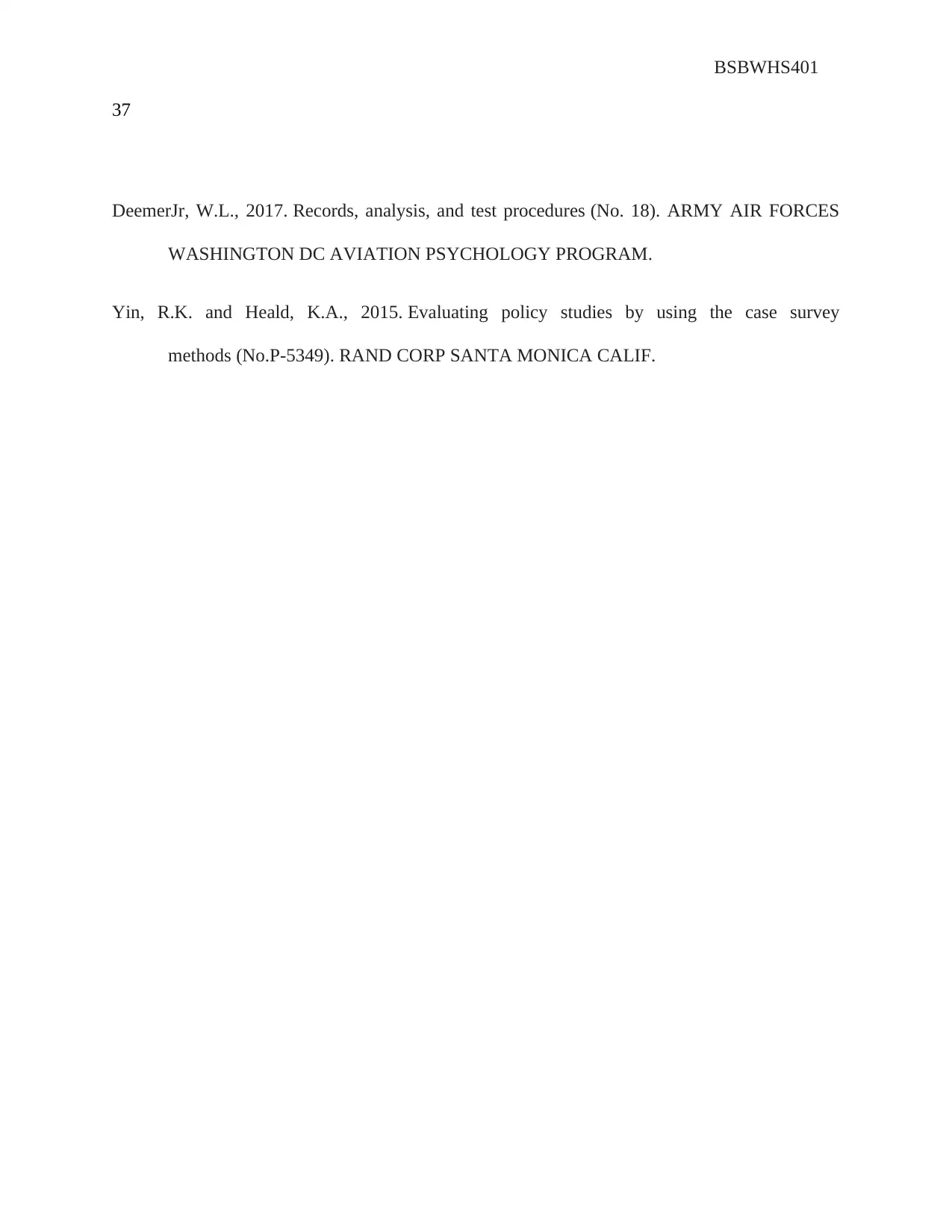
BSBWHS401
37
DeemerJr, W.L., 2017. Records, analysis, and test procedures (No. 18). ARMY AIR FORCES
WASHINGTON DC AVIATION PSYCHOLOGY PROGRAM.
Yin, R.K. and Heald, K.A., 2015. Evaluating policy studies by using the case survey
methods (No.P-5349). RAND CORP SANTA MONICA CALIF.
37
DeemerJr, W.L., 2017. Records, analysis, and test procedures (No. 18). ARMY AIR FORCES
WASHINGTON DC AVIATION PSYCHOLOGY PROGRAM.
Yin, R.K. and Heald, K.A., 2015. Evaluating policy studies by using the case survey
methods (No.P-5349). RAND CORP SANTA MONICA CALIF.
1 out of 37
Related Documents
Your All-in-One AI-Powered Toolkit for Academic Success.
+13062052269
info@desklib.com
Available 24*7 on WhatsApp / Email
![[object Object]](/_next/static/media/star-bottom.7253800d.svg)
Unlock your academic potential
© 2024 | Zucol Services PVT LTD | All rights reserved.





